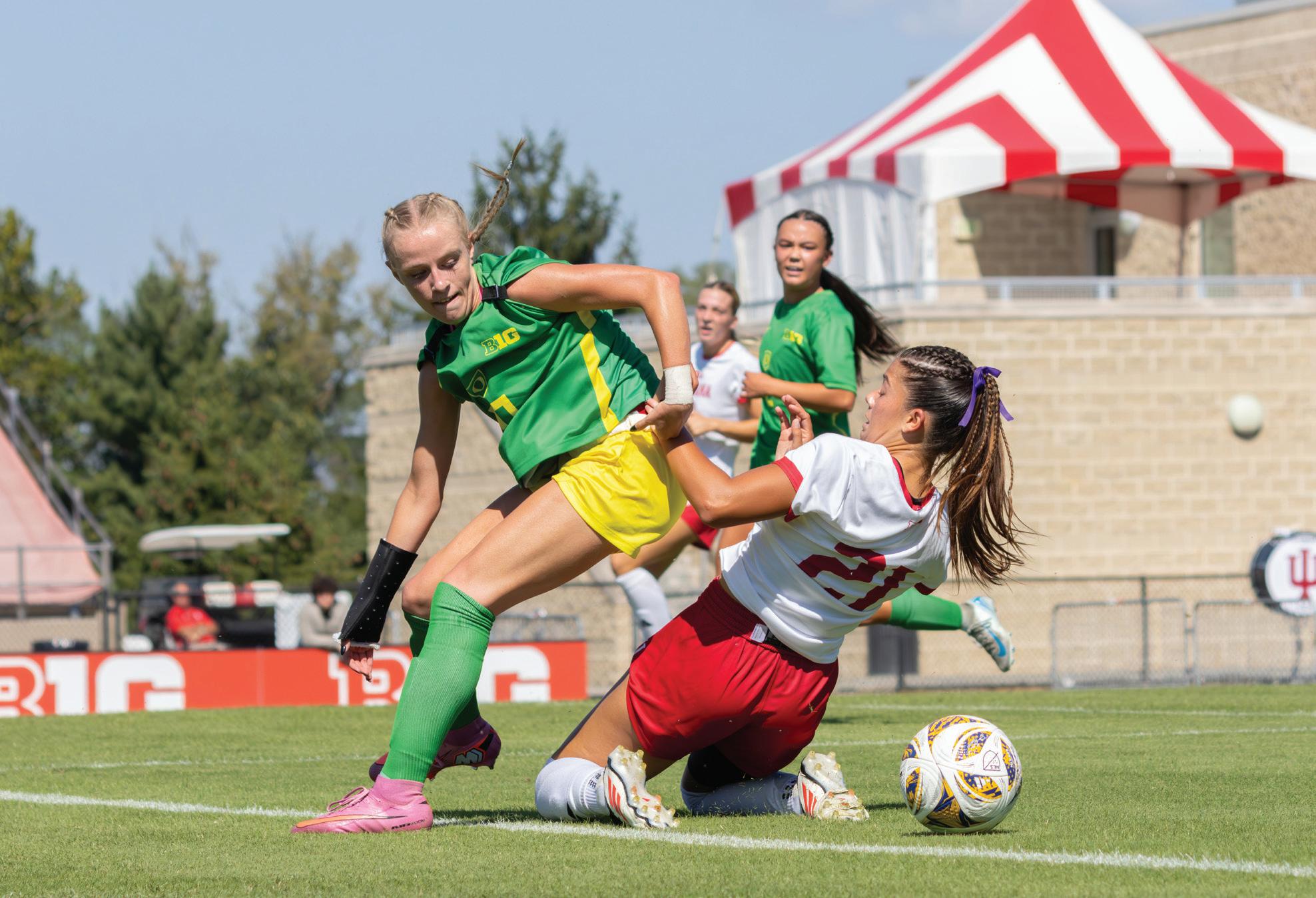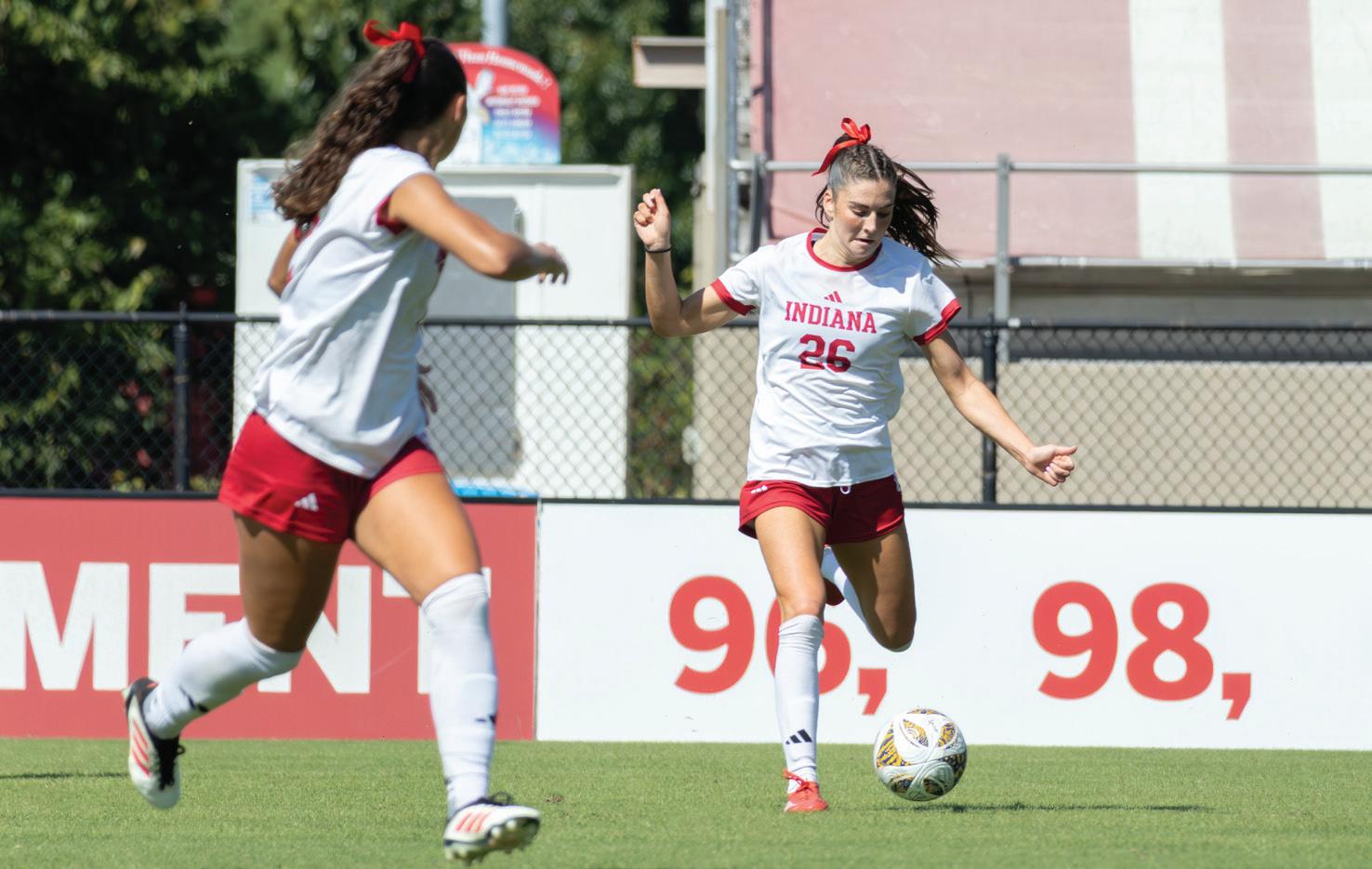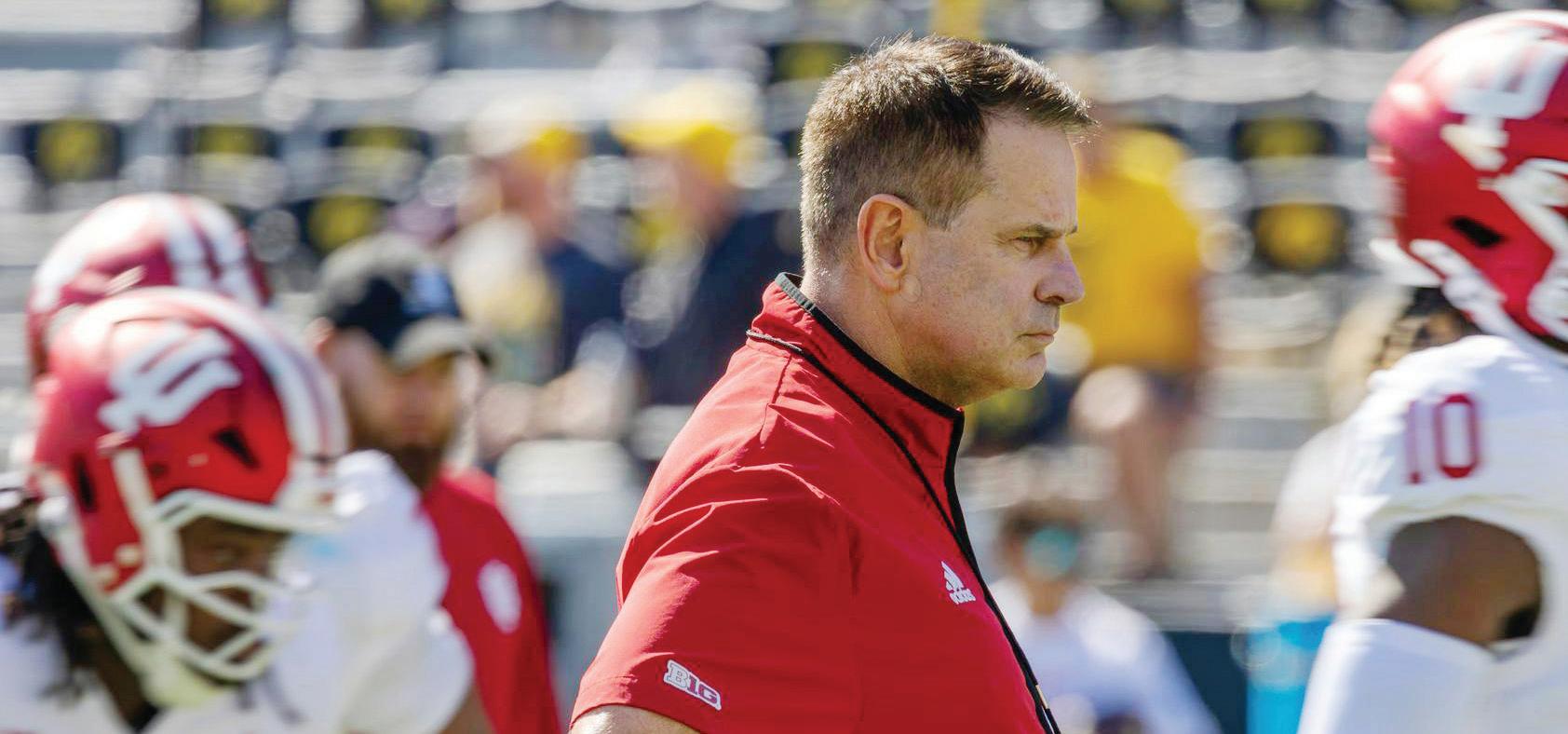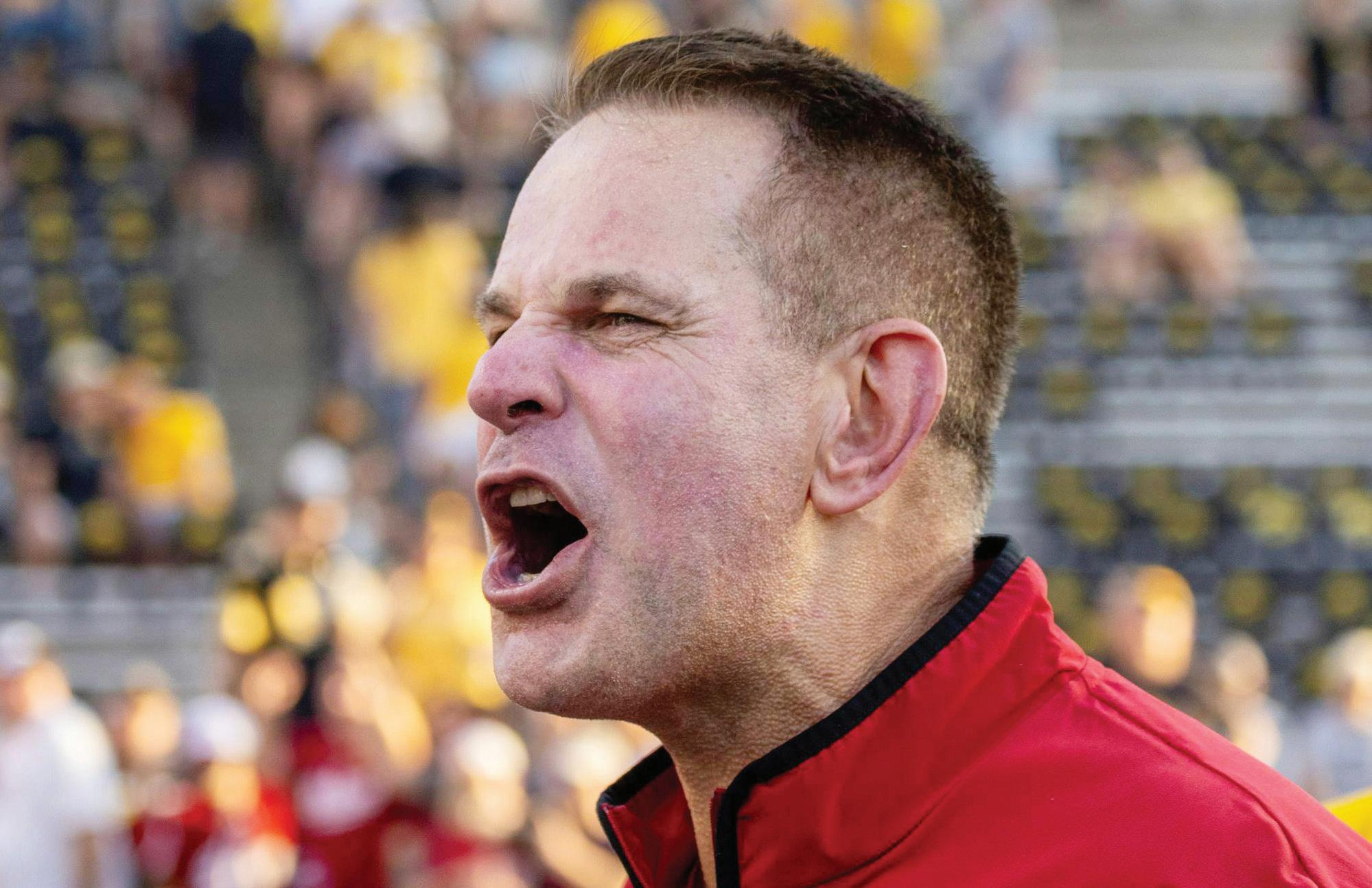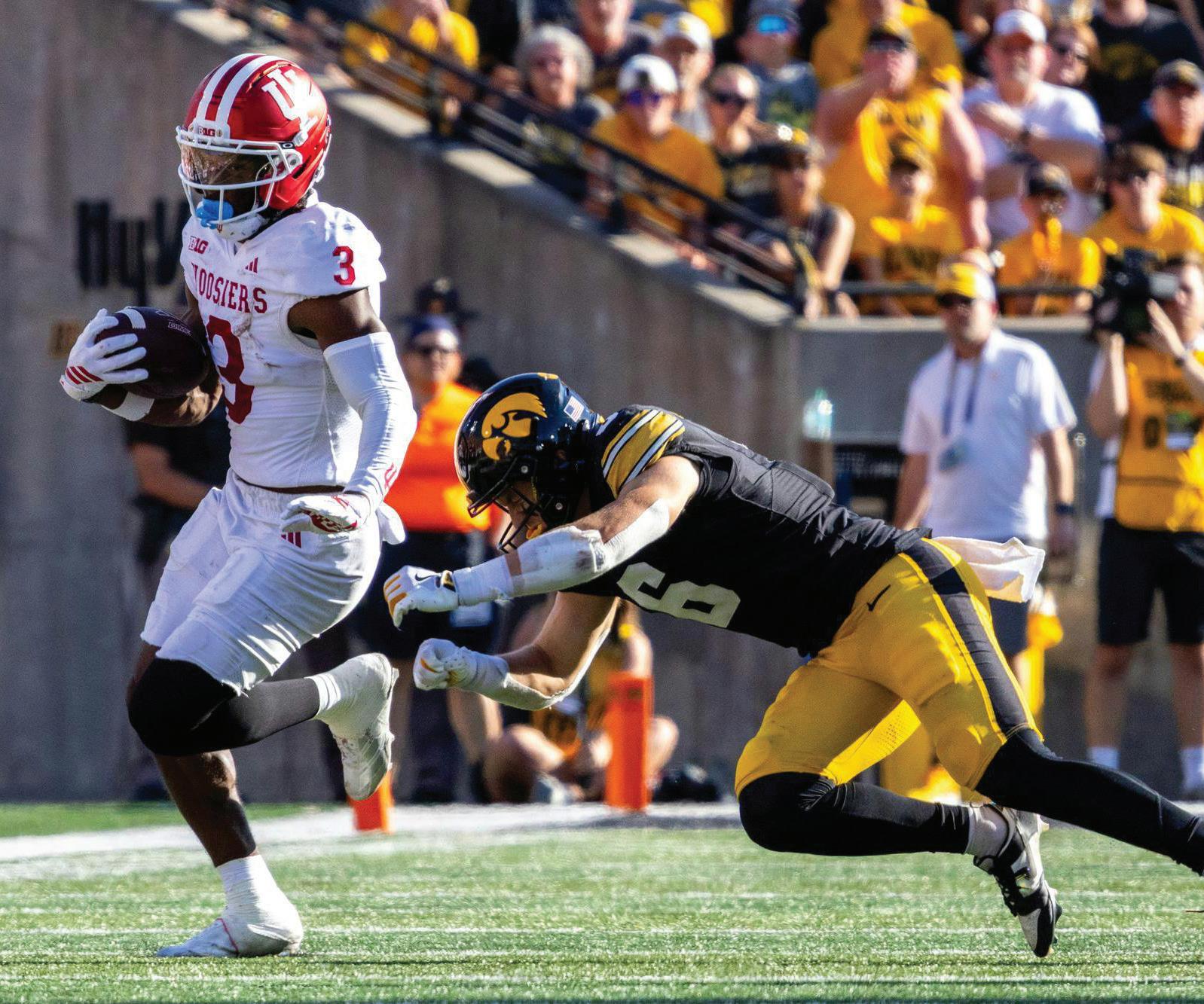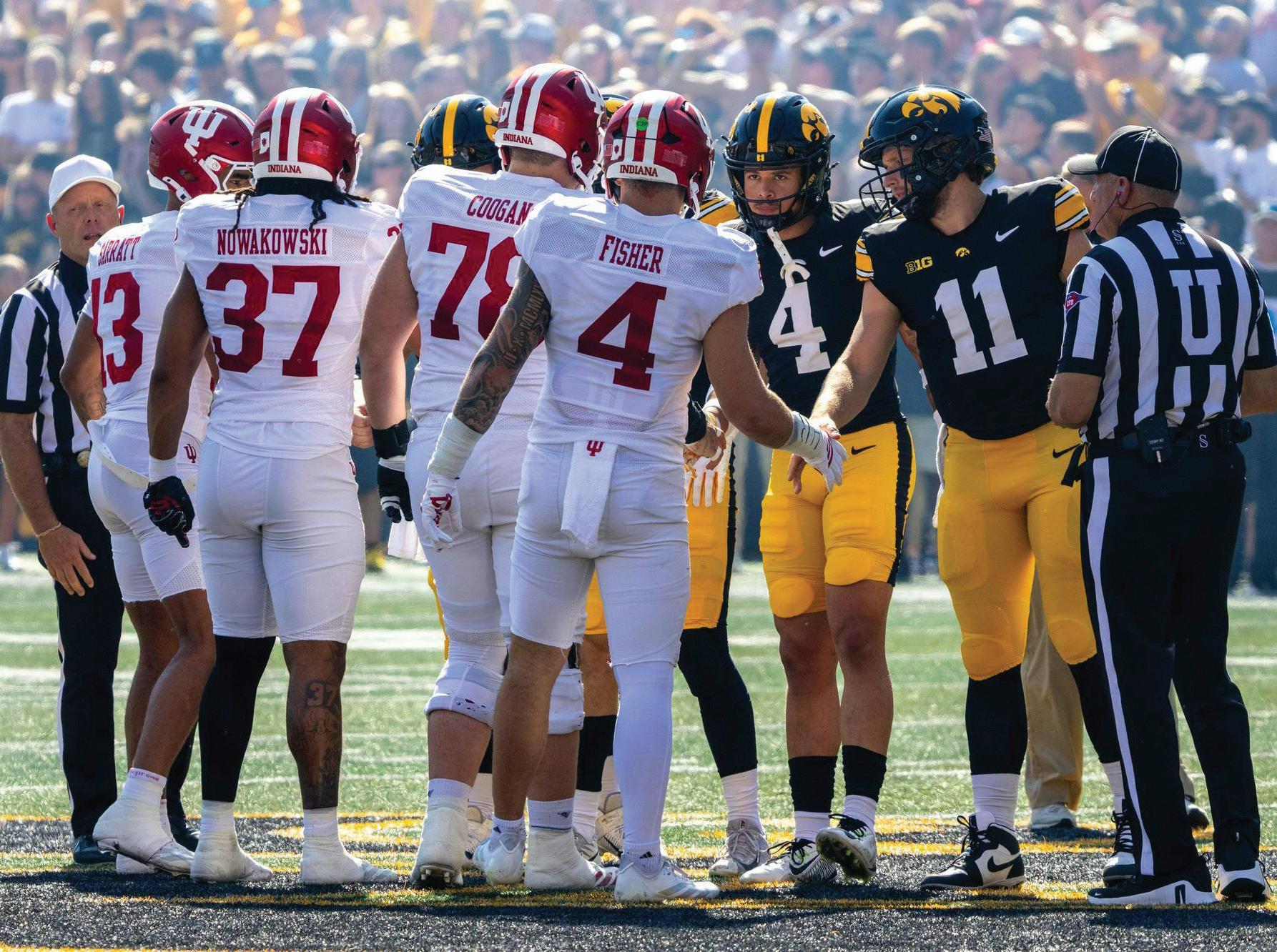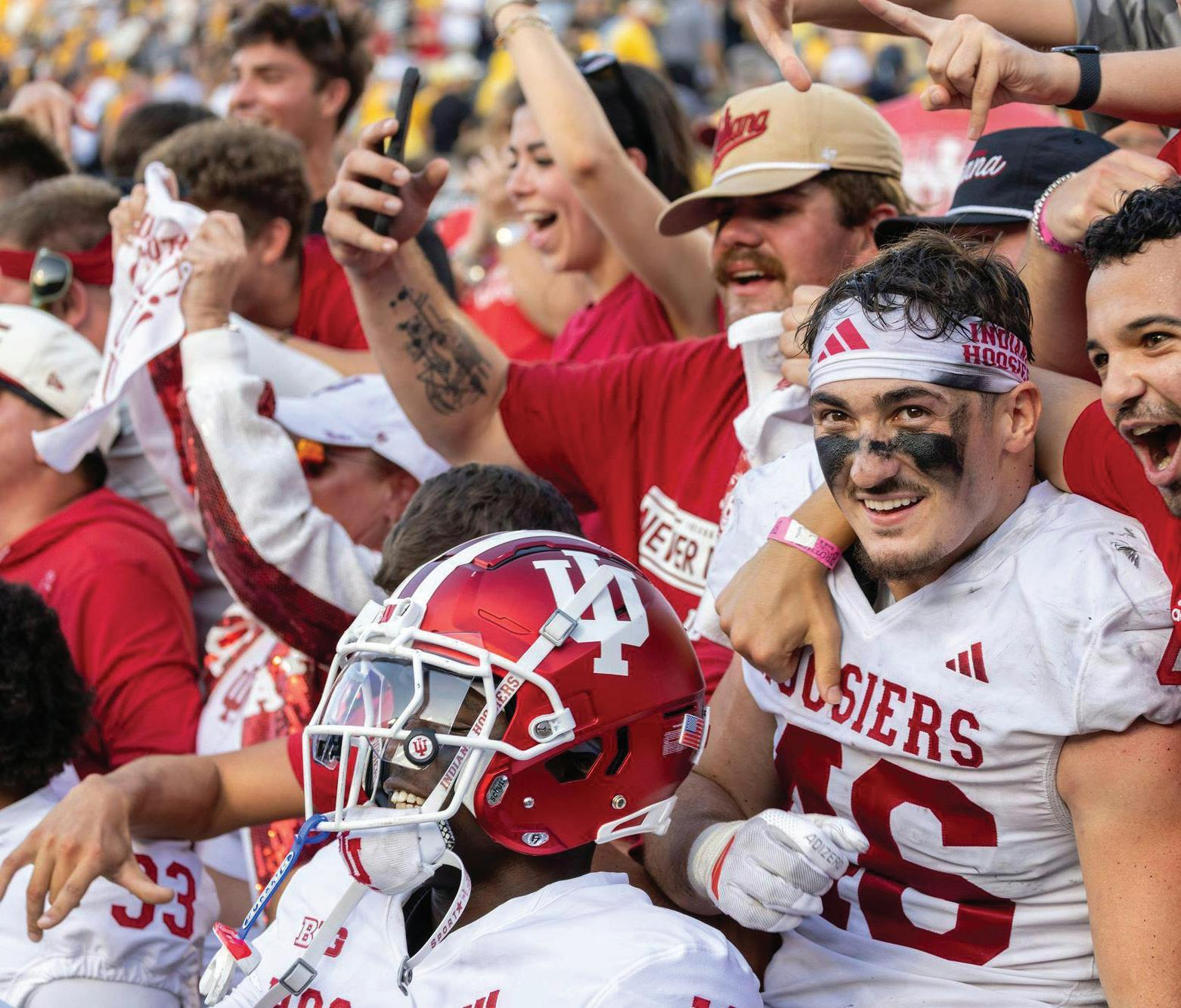IDS
Indiana Daily Student | idsnews.com



IU put a decades-old language program on hiatus. Former participants are advocating for its return
By Samantha Camire scamire@iu.edu
A decades-old IU language immersion program for high schoolers is on hiatus, with no clear plans to resume operation.
The Indiana University Honors Program in Foreign Languages gives high school students the opportunity to study and live in a foreign country over the summer. Students give up their phones and pledge to speak only the target language for the duration of the program, ensuring complete immersion in their host country.
They live with host families and attend classes in the mornings, while afternoons are filled with cultural excursions. Since 1962, the program has sent nearly 9,000 students abroad.
IU first shared news of IUHPFL’s hiatus Aug. 13, when Jennifer Engel, Associate Vice President for International Affairs and Education Abroad, sent an email to those closely affiliated with the program.
In her email, Engel cited declining enrollment as part of the reason for the decision.
“We do not yet have a set timeline for this hiatus,” Engel said. “Our priority is to ensure that any decisions about the program’s future are made thoughtfully and with the best interests of our students and stakeholders in mind.”
Engel did not respond to a request for comment in time for publication.
IU junior Jackson Wright studied German in Graz, Austria, in 2022 as part of the program. After he matriculated at IU, he became a student intern for the program, helping to share it with high school students through social media.
“I was a completely different person when I came back from Austria,” he said. “It was a very new experience, but also one that completely changed my life for the better.”
Wright credits the expe-

rience with teaching him self-reliance and independence; without his phone, he couldn’t look up words in German when he struggled with the language or call friends and family back home to ask for advice.
Wright says the transition to college was seamless thanks to his time with the program.
“It’s really the people that make it run. And losing that contact with the people is going to make it more difficult.”
Corentin Mazet, French instructor
“I’ve been across the world on my own for five weeks, I can be an hour away from home and be fine,” he said.
He also said studying abroad helped him find his career path and is now
majoring in German education, hoping to teach the language. He said he has often imagined telling his future students about the program and the effect it had on him.
Jane Gilbert, a doctoral candidate at IU and program veteran after four summers as a French instructor, said she has seen her students grow tremendously both linguistically and personally during their time abroad.
“They get so much more independent and confident, and they end up really proud of themselves for having accomplished something so difficult,” she said.
To advocate for the reinstatement of the program, Gilbert created a website where alumni and prospective students can share their thoughts and experiences. She hopes to bring the responses to Engel.
“It’s just a fantastic pro-
gram and we risk losing a lot more than just a couple weeks of a summer trip,” Gilbert said. “It’s a lot of college readiness, interpersonal relationships, the career trajectory.”
Corentin Mazet was also a French instructor with the program for three summers. Though he could make the same amount of money and do less work staying in the states as a summer IU instructor, Mazet said, he loves IUHPFL for the relationship he creates with his students.
He worries that the longer the program is on hiatus, the less chance there is of it being reinstated. As time goes by, he said, the university will lose valuable connections with host families and organizations in the host countries.
“It’s really the people that make it run,” he said. “And losing that contact with the people is going to make it more difficult.”
By Natalia Nelson nelsonnb@iu.edu | @natalianelsonn
Indiana University’s budget for the 2026 fiscal year increased by over $133 million from the previous year to $4.534 billion. The increase came despite state and federal funding cuts to the university and a flat instate undergraduate tuition rate.
Indiana’s state budget bill reduced higher education funding, cutting IU’s appropriations by 5%. Another 5% was withheld by the State Budget Agency, which helps review submitted budget requests and allocate appropriations.
In the new budget, IU Bloomington saw a reduction in employee benefits and travel costs and an increase in financial aid, academic compensation and staff compensation. The budget included a 2% compensation increase for all employees, which is similar to increases between previous years. Research, student support, instruction and public service funding also decreased. The university announced in May that IU planned to cut over $100 million in expenses from its 2026 operating budget by
eliminating unfilled positions, putting a cap on operational expenses and reducing support for non-academic programs. According to the budget document, the $100 million reduction was included in the budget, despite its overall increase.
Also in May, Gov. Mike Braun requested that Indiana public universities hold tuition and fees for in-state undergraduate students flat. Across all its campuses, IU receives nearly $1.7 billion of its funding from student tuition and fees. Out-of-state student and graduate student tuition rates increased marginally.
The new budget is significantly shorter and less detailed than last year’s budget, with the document spanning only 62 pages versus last year’s 377. The account summaries portion of the budget, which details the expenditures of different IU department accounts, was absent.
The Board of Trustees approved the budget in its June meeting, and an IU spokesperson told Indiana Public Media it had planned to release the budget in August “because of additional data finalization following Board of Trustees approval.” It was not made public until Sept. 30.

By Conor Banks conbanks@iu.edu
With just over two and a half minutes left in the third quarter of its season-opener against Old Dominion University, Indiana football redshirt junior linebacker Isaiah Jones logged his first career solo sack, forcing the Monarchs into a third and 12.
On the next play, Jones teamed up with sixth-year senior defensive back Louis Moore to stop Old Dominion short of the first-down mark, decimating its chances at staging a 27-7 comeback.
After redshirting his freshman year and spending the next two seasons in a reserve role, Jones has blossomed into a key piece, fortifying the Hoosiers’ linebacker unit.
“I think what you're seeing there is just another year of maturity,” Indiana head coach Curt Cignetti said during media availability Sept. 22. “He was on the team before I got hired. Had a back issue, so missed a lot of the season before. Got to play last year quite a bit. And he's just, the natural progression of reps accumulating, bigger, stronger, faster, older, wiser, that kind of thing.”
The London, Ohio, native was ranked the No. 20 overall player in Ohio by 247Sports and tabbed as a three-star recruit before enrolling at Indiana in 2022. Jones flashed as a rotational piece in 2024, collecting 42 total tackles and 3.5 tackles-for-loss across 13 appearances and two starts.
But the Hoosiers lost linebacker Jailin Walker in the offseason, which left a gap at the position, and Jones took full advantage.
Now, he has cemented himself as a cornerstone of the Hoosiers’ defense, leading the Cream and Crimson with eight tackles-for-loss and 3.5 sacks through the first five games of the season. However, Jones’ impact on the field extends beyond the stats, as he has established himself as a vocal presence in the locker room.
“Just being able to you know, find myself, you know, find my voice as a player and a leader on the team,” Jones said on an episode of the “Under the Hood with Indiana Football” podcast on Sept. 17. “And just kind of just doing my job and letting guys know that I can complete my job and have confidence in me.”
The redshirt junior strung together a career game against Indiana State University on Sept. 12. Jones wreaked havoc on the Sycamores’ offense throughout the evening, registering four total tackles, with 2.5 tackles-for-loss, and a sack. Jones followed up his career outing against then-No. 9 Illinois on Sept. 20, as the Fighting Illini offensive line struggled to contain Jones. The redshirt junior sliced into the backfield to rack up two tackles-for-loss and a solo sack, contributing to a loss of 18 yards for the Illinois offense. Jones’ defensive energy propelled the Hoosiers to a commanding 63-10 victory in the ranked matchup. While much of the soldout crowd at Memorial Stadium may not have known his name before kickoff, Jones’ performance commanded attention from the Hoosier faithful.
After the dominant win over Illinois, senior linebacker Aiden Fisher lavished Jones with praise.
“He does all the right things,” Fisher said. “This year he took a step, just physically playing, but I think mentally the game has slowed down for him. He started to see things a lot quicker. He comes in and watches film with me, we watch film with Coach Haines. In the meeting room, he’s answering quick. He’s so confident in himself and I think that’s really what you’re seeing every Saturday, is the confidence he’s playing with. He’s done a great job and he’s playing phenomenally right now.” Jones’ weekly work ethic paid dividends in Iowa City, Iowa. The Hoosiers defeated the Hawkeyes 20-15 at Kinnick Stadium — a hostile road environment —where Jones extended his impact to special teams.
Facing a fourth and 7 from their own 29-yard line in the third quarter, the Hawkeyes sent their punt unit onto the field. But the Hoosiers began their next possession in prime field position at their own 42-yard line, after Jones blocked the punt — the first blocked kick of his career. The rise of Jones from a backup to a leader and breakout star on the Indiana defense has helped power the Hoosiers to a 5-0 start to the 2025 season and established a defensive unit that has surrendered just 221.4 yards per game — the fifth lowest mark in the nation.
By Deshna Venkatachalam devenkat@iu.edu
Editor’s
By Molly Gregory mogrego@iu.edu | @mollygregory22
Vivian Winston, a former Indiana University Board of Trustees member, spoke publicly Sept. 24 about her experience as an IU trustee for the first time since Gov. Mike Braun removed her from her position.
At a Bloomington Press Club meeting, Winston discussed the decline of her confidence in IU President Pamela Whitten, her concerns about the administration’s transparency and the “culture of fear” she said has developed at the university.
Braun removed Winston from her alumni-elected position May 31, around a month before her term was set to expire. He was enabled to do so by a last-minute addition to the state budget that altered the board’s structure, giving Braun the authority to choose all its members.
Winston said she has reached out to Braun via email multiple times to discuss the state of the university but received no response.
She also said she had not been in active communication with Whitten since April 2024, when IU Bloomington faculty members passed a 93.1% no-confidence vote against the president.
Though she was the sole dissenter against Whitten’s reappointment in February, Winston said she fully supported Whitten at the beginning of her term in 2022 and met with her often.
“I was so impressed with her,” Winston said. “I don’t know if you’ve seen this side of her, but she can be so very charming.”

Whitten called Winston immediately after she was elected as a trustee and scheduled two two-hour meetings with her, Winston said. Up until the noconfidence vote, they met monthly for coffee.
However, IU’s response to the pro-Palestinian encampment in Dunn Meadow that began in April last year dismayed Winston. An overnight change to IU’s expressive activity policy enabled police to arrest 57 people who were protesting, including students and faculty, which Winston said raised concerns about transparency.
After the Dunn Meadow arrests, the BOT released
a statement announcing it would conduct a campus climate survey, a decision Winston said she did not support.
“I didn’t have anything to do with the statement coming out,” Winston said.
“If I had been involved, I would have wanted something besides a campus climate survey because I think we already had a pretty good idea what the climate was — angry.”
From unforeseen dismissals to sudden policy modifications, Winston said faculty and students received little notice or justification for major changes on campus. She said she knew of three
IU faculty who had been abruptly fired and never informed why.
The Indiana Daily Student could not independently verify that statement’s validity.
“One person I know was fired by email,” Winston said. “They gave her one day’s notice. They said, ‘don’t come in tomorrow, we don’t need you anymore.’ No help in getting a job in another department, another area. She was just fired.” She said this type of dismissal with no advance warning, in addition to updated tenure policies and decreased faculty emeritus rights enacted through the state legislature, has led to
faculty feeling insecure in their jobs.
“There’s such a culture of fear on campus,” Winston said. “I don’t ever recall having seen that before.”
An IU representative did not reply to a request for comment on these allegations by the time of publication.
These conditions, Winston said, have led to other universities poaching IU faculty.
“It puts us in a very bad position when we are competing for the best and brightest faculty,” she said.
“You think of a potential faculty member that’s considering us or University of Michigan, the University
of Michigan
could take two minutes and say what I just said, and then they could throw in the fact that the president got a 93% vote of no confidence and the board did nothing.”
Winston calls for improvements
Community engagement and accountability were at the heart of Winston’s recommendations for improvements.
“The governor, one of the things he said he wanted was transparency, and the other was accountability,” Winston said. “We are not getting that at all from Indiana University.”
She outlined several questions that are yet to be answered by the university, including why the review of Whitten’s alleged dissertation plagiarism has not been released and why Whitten’s reappointment contract is not public. In reference to Whitten’s plagiarism allegations, Winston said The Indiana Promise, which new students learn at orientation, seems to apply only to students.
On the IU admissions page, the promise reads: “I promise that I will be ethical in my academic work. I will take personal responsibility for what I say and what I do. I will respect the dignity of others, treating them with civility and understanding.”
To remedy the issues she laid out, Winston suggested that trustees interact more with other stakeholders at the university.
“The trustees need to make it a point to go out and talk to vice presidents, deans, faculty, students,” she said. “They need to be talking to everybody.”
By Ella Curlin elcurlin@iu.edu
Two years ago, the area in Crestmont Park along 13th Street was an empty grass field. Now, rows of tree saplings are sprouting.
Volunteers with Bloomington’s Urban Greenspace programs lined up and planted tree seeds across a patch of land next to the parking lot, spaced every two feet, retired forester Ray Major said. They repeated that process seven times across three city parks.
The taller saplings are now over five feet tall.
The Urban Greenspace volunteers planted these trees to supplement Bloomington’s tree canopy. In 2019, a report by Davey Resource Group found Bloomington’s canopy covered 38% of the city out of a possible 61%. The canopy heavily mitigates the city’s water pollution by diverting rain from polluted surfaces like sidewalks and gutters while also improving air quality by absorbing air pollutants and carbon emissions.
That canopy is under increasing strain. Some neighborhoods are losing trees due to development, Ava Hartman, director of local nonprofit CanopyBloomington, said. Other trees die off due to disease or invasive bugs, including the emerald ash borer, which eats and kills ash trees.
Bloomington Urban Forester Haskell Smith said the city’s maple trees have been declining due to worsening
periods of drought, while rainy springs are damaging the health of pine trees.
Smith also said residents frequently tell him they can’t keep up with the costs of planting or managing trees.
This is the first year of the Parks and Recreation Department’s Tree Assistance Program, which arranges tree care for qualifying Bloomington homeowners. The program plants trees and prunes or removes and replaces high risk trees, such as dead, damaged or invasive trees.
The city will pay a percentage of these service costs up to a maximum amount based on income. The maximum cost covered for tree removal or mitigation is between $1,500 and $2,500, while tree plantings are capped between $270 and $450. Applications for the program closed Oct. 1, and work will begin in spring 2026.
CanopyBloomington also works to reduce the costs of tree ownership by arranging volunteer-led tree plantings. Neighborhoods or residents can reach out to CanopyBloomington to request a planting in their area.
CanopyBloomington, said. chooses planting areas based on its priority map, which outlines areas based on their environmental impact on soil and water quality and the social metrics of the neighborhood, including income, population density and racial demograph-
ics.
Once an area is selected, Hartman said members attend neighborhood meetings, host potlucks and go door to door to offer nearby residents the chance to get a tree planted in their yard.
CanopyBloomington has neighborhood plantings scheduled for Oct. 18 in the Waterman neighborhood, an Oct. 25 planting at the Near West Side neighborhood, and a Pigeon Hill neighborhood planting Nov. 8.
The plantings usually last about four hours, and volunteers are taught how to plant a tree, Hartman said.
“Residents and volunteers are working together to get those trees in the ground, and then at the end we have a little celebration,” Hartman said. “So, we’ll have music and food and people just talk and have a good time.”
At Crestmont Park, volunteers gather every Monday for a Weed Wrangle, where Major said they cut weeds and layer the stems around the base of the seedlings.
Major said this smothers any weeds that would grow around the trees’ base and boosts the nutrients and moisture in the soil, serving as a natural, free mulch.
“Many people regard such a mulch as not very pretty,” Major said. “So people may or may not want to do it in their lawns. But the point is, it works. The material was here and readily available.”

Major owned a tree farm in southern Indiana for 45 years before retiring to Bloomington. Now he shares information on tree care through the Facebook page Trees from Seed and teaches volunteers with the city’s Urban Greenspace programs how to plant trees from seeds instead of using nursery-grown saplings.
Bloomington’s Parks and Recreation Department provided cages for the saplings at Crestmont Park to keep deer from eating the tops of the leaves. At about $5 for
a small cage and $30 for a 6-foot cage, Major said the cages were the most expensive part of the process.
Nursery stock trees, or pre-grown potted saplings, can cost several hundred apiece, Major said. Once planted, because their roots are still embedded in their potting soil, they can struggle to pull nutrients and moisture.
Major said it can take longer to see results with trees planted from seed, and the seedlings require a specific kind of care. But
planting this way can save money for homeowners and help restore city canopies at a time when federal cuts are impacting funding for parks departments and environmental nonprofits nationwide. Major said one of the biggest barriers to planting trees this way is convincing landscapers and city residents to give the seedlings time to grow. “That’s the hurdle to overcome, is instilling enough faith and patience in people to plant them,” Major said.
By Shivam Mohapatra
Construction continues for one of Indiana
University’s most historic buildings as the Bill Garrett Fieldhouse undergoes renovations. Due to limited access to the fieldhouse until next summer, students are experiencing overcrowding and frustration at the Student Recreational Sports Center. Hannah Armstrong, associate director of operations for Recreational Sports, said in an emailed statement that the goal of the project is to improve
the facility, built in the late 1920s, into a more modern space. The project is slated to be completed by summer next year.
The construction mainly focuses on infrastructure improvements, such as installing new air handling systems, ductwork, fans and plumbing infrastructure.
Other improvements will include updated classrooms and labs, which Armstrong said will benefit students. Those labs, she said, will have improved lighting and airflow.
Also among the list of the project’s plans is a new
locker room next to Royer Pool. Hayden Hurst, a freshman, said he is excited about gaining access to these new spaces.
“I’m hoping to see the construction being done as fast as possible so I can utilize the Fieldhouse to get some exercise in between classes,” Hurst said. “It’s getting exhausting when walking up the hill to the SRSC.”
IU freshman Savya Dhingra said he plans to use the facilities as a sophomore next fall.
“I can’t wait to play basketball with my friends once it’s finished,” he said.
“I’m excited.” Construction on Bill Garrett Fieldhouse has brought frustration for some students. With the fieldhouse temporarily closed, the SRSC has experienced increased congestion as students look for alternatives to get their exercise in. Dhingra and Hurst said there have been longer wait times for equipment. The gym’s group fitness classes are packed, they said, and the facility is filled to the brim during peak hours.
“Ever since the construction started, I’ve had to cut my workouts
short or skip them because the gym is too packed,” freshman Felix Manu, a frequent gymgoer, said.
The overcrowding at
the SRSC affects students’ daily routines and workout schedules, sometimes even discouraging students from going entirely, freshman Myles Houston said.
“I feel less inclined to go because the wait times can be frustrating,” Houston said. “When I want to play basketball with my friends, the courts are all full, and when I want to get a lift in, most of the machines have a wait time.”
The renovation follows a
two-phase approach, with phase one completed and phase two underway.
Armstrong said phase one focused on initial improvements and updates to parts of the building. Phase two will involve more major mechanical work. More details are expected in fall 2026.
Armstrong said using this strategy allows portions of the building to remain functional while construction continues in other sections. While this helps reduce some of the disruption, students still face limited access to a full range of facilities.
Max Moore (he/him)
is a junior studying political science and journalism.
Two weeks ago, Charlie Kirk was tragically shot and killed at Utah Valley University while conducting a public debate on the campus. The alleged killer, 22-year-old Tyler Robinson, has been apprehended and charged with aggravated murder, though his precise motives remain unclear. In the aftermath, much of our country’s energy has been devoted to theorizing Robinson’s ideology and placing blame on opposite sides of the political aisle. Regardless of the killer’s intentions, one fact remains true: A firearm turned internalized anger into an act of public political violence.
Discourse must turn to that truth, because political violence and gun violence are indisputably linked in American society. Although violent rhetoric and political polarization fuel attacks worldwide, it’s no secret why political violence is rising in the country with the highest rate of civilian firearms.
Despite a push to assign political violence to political parties, gun-related attacks continue to wreak horror regardless of ideology. This past June, a man broke into Minnesota state representative Melissa Hortman’s home, assassinating her and her husband. Violence clearly impacts both parties. However, what unifies both attacks are the weapons that make lethality just a trigger pull away. Political attacks such as Kirk’s and Hortman’s bring momentary attention to our country’s gun epidemic before ultimately devolving into a finger-pointing contest that results in little to no legislative reformation. As the country continues debating ideological causes, the persistent issue of gun violence remains unsolved, not because solutions don’t exist, but because sensationalism remains a higher priority than safety. While political assassinations dominate headlines, the daily reality of gun violence plays out in schools and neighborhoods with far less attention.
On the same day Kirk was murdered, a 16-year-old high school student entered his high school and opened

fire with a revolver, wounding two students and ending his own life. It’s no surprise that Kirk’s high-profile status would draw all the attention. Still, the lack of national coverage surrounding the Evergreen High School shooting further highlights the concerning lack of attention toward the cause of these tragedies.
Guns became the leading cause of death for American children and teens in 2020, overtaking car crashes. According to the Johns Hopkins Center for Gun Violence Solutions, the firearm death rate among children aged 1-17 has increased by 106% since 2013. Firearm death rates drastically increased during the onset of the COVID-19 pandemic, with rates rising by 50% between 2019 and 2021. Around this same time, gun purchases also saw an increase, with 18% of American households purchasing at least one firearm between March 2020 and 2022. The research is indisputable: Gun violence in America is an epidemic, and it’s only worsening. The ques-
tion becomes what we as a country can do about this issue. As always, the answer lies in the data. What research tells us is that stricter gun laws do, in fact, decrease gun-related deaths.
In 1995, Connecticut adopted permit-to-purchase requirements (PTP), which made purchaser licenses a requirement to buy firearms. Over the next 10 years, the state saw a 40% reduction in firearm homicide rates. On the other hand, Missouri repealed PTP in 2007, and by 2010, gun homicides increased by 23% and again by an additional 16% in 2012. This trend between states adopting reforms such as PTP and those that did not continues to be consistent in my research. Furthermore, states with waiting period laws reduce gun homicides by 17% on average, with experts estimating a national adoption could save 750 lives a year. These trends can also be seen outside the United States, with many countries observing tremendous success after adopting stricter legislation. Australia signed
the 1996 National Firearms Agreement banning a multitude of firearms, and since then, it has not had a single mass shooting. Not one. The U.K. Parliament passed the Firearm Amendment Acts following the Dunblane school massacre in 1997, where 16 children and a teacher were killed by a gunman with an illegally-owned handgun. Since then, gun homicides have dropped sharply and the U.K. has not seen a school shooting like Dunblane since. By 2021, deaths had fallen to just 35 a year, with that number dropping to 22 in 2024.
It’s clear what happens when gun laws become stricter but what about the opposite? Between 2015 and 2022, 20 Republicanled states passed bills loosening requirements to own guns. Rather than taking a research-based approach, states believed permit-less carry would increase safety in communities and schools, where they argued for arming educators. Twenty-six states now allow concealed carry without permit or training requirements, meaning
JOAQUIN’S JOURNAL
Joaquin Baerga (he/him)
is a junior studying journalism.
Tramell Tillman is the first Black man to win an Emmy on Sept. 14 for outstanding supporting actor in a drama series. His win feels emblematic, since his “Severance” role mirrors the very inequalities Hollywood reproduces.
The category was the only one that had yet to honor a Black performer in the Emmys 77-year history. During the show’s first season in 2022, Tillman was overlooked among the series’s 14 nominations.
Only 13 Black actors have been nominated in the supporting drama actor category since 1970, when it was formally established. The last Black actor nominations came in 2021, when Giancarlo Esposito, O-T Fagbenle and Michael K. Williams were recognized for “The Mandalorian,” “The Handmaid’s Tale” and “Lovecraft Country,” respectively.
In the 2025 Emmys, actors of color accounted for 24 of 94 leading acting nominees or 25.5%. This is the lowest share in five years, and it’s a sharp drop from the 2022 peak, when they made up 39%. These facts suggest a trend of racial inequality in the Emmys, but this issue extends beyond the award ceremony and its nominees. The film and TV industries as a whole are plagued by inequality. Black actors account for 11% of leading film roles, which is lower than their overall presence in casts (13.4%). In 2024, 36.4% of all speaking characters in topgrossing films were from un-
millions of Americans can obtain a firearm more easily than a driver’s license. And what happens after these states drop permit laws? A national analysis found that 16 of the 20 permit-less carry adopting states saw significant increases in shooting fatalities, with states like West Virginia seeing an increase of 48% in the four years following adoption relative to years 1999-2015.
Many communities do try to take research-based approaches, but challenges still arise. In Indiana, the Indianapolis City-County Council passed a safety package in 2023 that would have raised the purchase age to 21, equired permits and banned assault weapons within the city. However, these changes could not be implemented as the state does not allow local gun laws. Indianapolis tried to act but was restricted by the same powers that are supposedly trying to stop violence.
Constitutional rights are real, and ideologies are too, but rights have never been a justification for limitless freedoms. The right
to free speech ends at the incitement of violence, the same way due process ends where obstruction begins. The Second Amendment isn’t special in this matter. Whether reform or complete abolishment is needed is for our country to decide, but what is clear is that change is needed.
Freedoms are one thing; this is not a push to remove the rights of the people. It’s a question of whether the absolute freedom of this right is worth the death and destruction it causes. If we are truly outraged by the assassinations of Charlie Kirk and Melissa Hortman, as well as the shooting in Evergreen and countless others, the conversation must move from attacking across party lines to one discussing how we can save lives. As our country continues to pin blame on one another, more Americans are dying from gun violence. It’s not a question of blaming the left or right; it’s whether we will choose to change or remain in ideological paralysis. mjm39@iu.edu
Tillman’s Emmy win mirrors his ‘Severance’ character arc
derrepresented racial/ethnic groups, even though they represent 41.6% of the U.S. population.
Tramell Tillman’s Emmy win feels paradoxical when you consider how award institutions mirror the systems of exclusion his “Severance” role critiques.
His character in the show, Mr. Milchick, embodies the contradictions of race and power in the workplace, acting as both a gatekeeper and a marginalized figure at Lumon Industries. He oversees the microdata refinement team, keeping them ignorant about their work and the outside world. However, while in a position of authority, he’s still a Black man navigating a predominantly white corporation.
The only other Black person we see interacting with him at Lumon is Natalie (Sydney Cole Alexander), who primarily serves as the “Board Liaison for the Severed Floor.” In the show, the severed floor is where Lumon workers enter a different state of consciousness. Their memories of the outside world are erased.
The mysterious board is a governing body of faceless, nameless voices. As the liaison between them and other employees, Natalie is also seemingly in a position of power. Both she and Milchick are unsevered, retaining outside memories and greater privileges.
Milchick and Natalie share a scene where she presents him with gifts on the board’s behalf: several “inclusively re-canonized paintings” to help him see himself in Keir, Lumon’s white, deity-like founder.
Milchick’s visible concern
upon seeing the paintings contrasts Natalie’s strained smile, underscoring Lumon’s diversity initiatives as hollow and performative. Rather than celebrating him, the company belittles Milchick, pressuring him to erase difference and feel honored to “see himself” in a white man.
This mirrors his Emmy win; both gestures are framed as victories for representation, but they raise questions about whether larger institutions are really moving forward or simply offering symbolic gestures.
We see a similar tension here in Bloomington. Indiana University closed its Office of the Vice President for Diversity, Equity and Inclusion in May, while the city proposed budget cuts to funds previously allocated to DEI training. These decisions suggest weak institutional commitments to diversity that can be treated as expendable.
Tillman’s Emmy celebrates progress, but it’s a reminder that inequities exist. These local withdrawals of support show the fragility of commitments to equity.
Another important part of Milchick’s character arc in season two is the friction between him and Mr. Drummond, a high-ranking enforcer for Lumon Industries. Milchick’s vocabulary is eloquent, and Drummond polices it.
There’s a specific scene where Drummond conducts a performance review for Milchick, reprimanding him for using “too many big words.” Tillman himself theorizes that the problem has to do with his character’s race.
“Maybe they feel that this

Black man should not have access to these words, and he shouldn’t speak this way,” he said. Toward the end of season two, Milchick defies Drummond by using longer words instead of following his order to simplify. This might feel like a small win, but it’s
in the hierarchy, where a Black character asserts agency in a white-dominated space. While it could be taken simply as a
Odessa Lyon (she/her) is a senior studying biology and English, pursuing a minor in European studies.
Rovers on Mars have made exciting finds and sensational headlines since bellbottom jeans were fashionable. Recently, the Perseverance rover discovered a “potential biosignature” on the red planet, raising the question: if we’re moving up and out, are we leaving our problems on Earth to worsen?
While “potential” and “biosignature” sound dramatic and scientific, they are far from certain. When misconstrued as anything more, this headline serves as fodder for President Trump’s flood the zone approach — a maelstrom of new legislative actions and social media posts to distract people from the unreleased Epstein files and overwhelm them into complacence.
Because what does the Trump Administration love more than revoking human rights? Distraction.
It is no coincidence, then, that he appointed Elon Musk, the CEO of SpaceX, to be the head of the U.S. Department of Government Efficiency — created by Trump to slash federal spending. They share a common love of speed above all: in his first month, Trump signed 46 executive orders and Musk fired hundreds of federal employees and cut diversity, equity and inclusion contracts in the position while racing to become the first trillionaire, no matter the cost — i.e., needless SpaceX worker injuries and unethical Neuralink animal subject deaths.
Musk’s boyhood idolization of America’s “cool technology” and upbringing in South Africa’s wealthy, segragated Pretoria suburb has grown into a dream of colonizing Mars, now that he’s already colonized his own

city, Starbase, a launch site in Texas.
Musk’s goal for his Mars colonization program “is to become a space-faring civilization and a multi-planet species,” as an alternative to “some doomsday event”: in other words, the world hunger he refused to solve, the rise of eugenics he’s posted in support of, the climate crisis his fossil-fuel-guzzling supercomputer drastically worsens.
A graduate school dropout turned entrepreneur, he fearmongers to finance a plan B when it’s plan A — our planet Earth — that needs funds and policies passed. Some, like Sara Webb from the Center for Astrophysics and Supercomputing of Australia’s Swinburne University of Technology, have
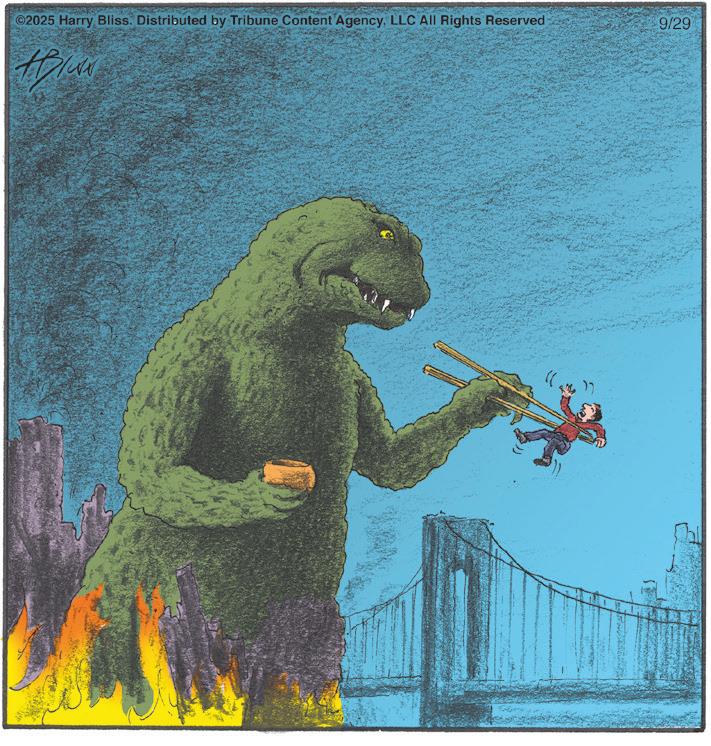
called Musk’s a “noble goal,” but for whom?
“I think the probability of establishing a self-sustaining civilization is very high,” Musk said at the 67th International Astronautical Congress on Sept. 27, 2016. “Not everyone wants to go... but enough would want to go, and who could afford the trip, that would happen.”
NASA’s sell-out collab with SpaceX Musk’s money, however, proves palatable to the taste of the public, even NASA.
Since the Cold War’s Space Race ended, a shrinking budget has led NASA to turn to commercial contracts, including in 2006 with Musk’s SpaceX, allowing the company to supply cargo and crew to the International



Space Station. Similarly, the president’s budget for Fiscal Year 2026 ratcheted up NASA’s budget, allocating over $7 billion for exploration to the moon and $1 billion to Mars. Interestingly, NASA’s previous director Bill Nelson expressed relief knowing Gwynne Shotwell, rather than Musk, makes decisions for SpaceX. Nelson further exposes Trump and Musk’s puppeteering of NASA with his complacent remarks after Trump gave his job to billionaire Jared Isaacman, ex-employee of Musk.
“I am optimistic because of the relationship that Musk has with Trump that NASA will get the funding that it needs because Musk will be advocating,” Nelson said in an interview with CBS News.
This nepotism was brushed off, conveniently, before the Trump administration issued the Aug. 28 executive order for NASA’s transition to intelligence, investigative or national security work; “No mention of that science and exploration stuff,” ex-NASA scientist Keith Cowing wrote in a blog post for NASA Watch. While Trump increases funding for NASA’s spy era on one hand and defunds food stamps and conservation efforts on the other, we must question our priorities. Is it really life itself that Trump and Musk value, since they care so little about current life on Earth?
The search for extraterrestrial life
The life on Mars argu-
by Patti Varol
ment has been around since 1971, when Mariner 9 first found evidence of water in Mars’s past. On Sept. 11, NASA announced the most direct evidence of life on Mars, ever. Last year, in one of these ancient riverbeds, the Perseverance rover collected sedimentary rock samples containing a combination of minerals that might have resulted from reactions to produce energy for growing microbial life.
The prominent theory for the current life on Earth is that it evolved from early microbes. However, these minerals could also have been produced without the presence of life, so this finding neither proves nor disproves anything. It’s just more evidence. The search for life on Mars must be measured and account for all confounding variables so as not to confuse indigenous life with life on Earth, like contamination from space missions.
Meanwhile, Musk’s settled on a launch schedule, picked out sites for colonization and drawn up plans for Mars’s first city like a new bride.
It should feel suspicious that NASA, now a spy agency controlled by the Trump administration but bankrolled by Musk’s SpaceX, is forcing a public revelation of life on Mars while Musk has been both preemptively planning for Mars colonization and ham-fistedly contributing to Earth’s collapse. Our hand is being forced by both sides for a plan B accessible to the few.
Carl Sagan famously said that “life is the hypothesis of last resort.” It’s a lazy and bad scientist who hopes for an outcome, rather than forming a hypothesis based on known variables: that’s the true scientific method.
oolyon@iu.edu
By Tara Holland








By Stella Klaus ssklaus@iu.edu
With musicians from Canada to China, the annual Lotus World Music and Arts Festival returned for its 32nd year. Spanning four days, the festival hosted musicians from around the world to expose Bloomington to other cultures.
The festival began with opening shows from Krista Detor Band and Terrance Simien & the Zydeco Experience. Both are from the United States, and Krista Detor typically plays around Bloomington without her band.
“You don’t get to see Krista with her whole band very often, so that was great to have a larger band,” Cindy Beaulé, WFHB disc jockey and former volunteer coordinator for the Lotus Festival, said. “Usually when she plays in town, she plays by herself.”
Terrance Simien & the Zydeco Experience, a band from New Orleans, was the other group to open the festival on Sept. 25. Beaulé said they were a “very danceable” group that connected with the audience through throwing Mardi Gras beads into the crowd. They often do this during their performances to create a lively atmosphere similar to the Mardi Gras celebrations in New Orleans.
Puuluup, a duo from Estonia, was among the artists who performed Sept. 26 and Sept. 27 and was one of Beaulé’s favorites. As a big fan of Nordic music, she was satisfied with this year’s lineup, which included musicians from Finland, Sweden and Estonia.
While many artists performed both Sept. 26-27, some performed just one day of the festival. Krista Detor Band and Terrance Simien exclusively performed during Sept. 25 opening performance, while House of Waters and Yeison Landero performed Sept. 26 only. The performances Sept. 27 began at the Sixth Street

tent at noon with Teho., a Finnish duo that mixes traditional Finnish fiddling with other styles such as bebop and western swing. They were followed by Zimbabwean band Dan Kusaya & the Chimurenga Inspiration. This was Kusaya’s third time performing at Lotus fest but his first time with a full band.
Kusaya’s performance was lively and interactive, with dozens of audience members dancing along to the music.
“It’s my favorite weekend of the year, I just love sort of marinating in these world cultures,” Amira Sabbagh, longtime Lotus Festival fan, said. “I’m a little bit of a dance freak, so I just get up there and when I hear the music I gotta move.”
After Kusaya’s set, Costa Rican band Matixando took the stage in matching shirts. Their band formed in Costa Rica but is now based in Bloomington. Consisting of 11 members, they combined many different instruments including four types of drums. Lead singer David Dávila González encouraged audience members to dance, saying, “it is not a crime to dance.”
While the first round of performances took place at
the Sixth Street tent, three separate workshops were held at the Waldron Arts Center to teach attendees different styles of dance.
Performer Nidia Góngora held a rhythm workshop focusing on Colombian Pacific music. There was also a swing dance workshop and a salsa workshop led by the Ritmos Latinos Indiana group.
“When we’re teaching people that haven’t danced before, we usually start with kind of what are the basics for salsa, what are those steps you can do if you’re just dancing by yourself, and then we put it to music, so how do you put these steps to a song,” Ian Herrman, salsa teacher for Ritmos Latinos Indiana and salsa workshop instructor, said. “Since salsa is a partner dance, we demonstrate how you dance it with a partner,. We connect, we talk through the different steps you do together and then we put that to music as well.”
After the first round of performances and workshops ended at 4 p.m., the festival picked up again at 6 p.m. with artists performing throughout all the venues, including the BuskirkChumley Theater, the Sixth Street tent, the Waldron Arts
By Sydney Weber syaweber@iu.edu
Katie Mysliwiec Slavin’s love of coffee began when she was a young girl growing up in Bloomington. She’d go with her dad to a coffee shop and order a hot chocolate, but not too hot. They’d sit, read The Ryder Magazine and catch up with acquaintances who happened to wander in. Mysliwiec Slavin loved spending time with her dad and the feeling of community she got in coffee shops.
Now, years later, Mysliwiec Slavin hopes to grow that same sense of community as owner of Needmore Coffee Roasters. The shop hosted an open house Sept. 27 at its new roastery at 1310 S. Monon Drive in Bloomington. The Needmore team moved their coffee roasting machine from the cafe to the garage-like space in January. The nine months since have been filled with setting up the roastery workflow, but once that was taken care of, Mysliwiec Slavin wanted to celebrate.
“Once we got into the good flow, I said, ‘Let’s have a party,’” she said. “I want everybody who wants to come check it out.” Flora Arthur, a cafe manager at Needmore, said the team wants to have more events like the open house, where the public can come and learn about what goes on behind the scenes.
“What sets Needmore apart is roasting specialty coffee from farms that are vetted for economic and environmental stewardship and taking care of their communities,” Arthur said.
These extra steps in sourcing mean that Needmore pays a premium on the beans it buys, Arthur said. In a time of rising prices, transparency is important.
“We want to make sure that people understand the value of what they have,” Arthur said. “And so, by having events like this and opening up to the public, we’re hoping to educate people on all of the work that goes behind coffee and the huge supply chain that is the backbone of all of it.”
Having the new space for the roastery was a needed change, Mysliwiec Slavin and Arthur said. Before this year, the coffee roaster was located inside Needmore’s cafe on North Pete Ellis Drive, vying for space with bakers and baristas.
“The roasting happening while the cafe was open at first was cool because people could ask questions, but then it got to where it was too much of a distraction and the roaster couldn’t focus,” Mysliwiec Slavin said.
Moving the bean roasting machine means that the staff have a dedicated space to work on producing great coffee without getting sidetracked, Mysliwiec Slavin said.
Visitors to the open house, like Nick Edwards and Brittany Penzer, came out to support Needmore and celebrate the new space. Penzer said she hopes it will give baristas at the cafe more room to move around. Edwards agreed.
“Yeah, when the roasting machine was in the shop, it smelled very nice, but it was very clearly taking up a big portion of the space,” Edwards said. He said he tries to go to the cafe every other week.
Arthur said the new space is already driving innovation in Needmore’s offerings, providing room for roaster Brandon Thorne to try new beans and blends.
“[The roastery] gives him a lot more opportunity to concentrate and to experiment and to have kind of his own zone,” Arthur said.
“More room for him to grow our business in terms of just the size that we’re able to produce.”
One such innovation is a “zombie desert bean,” Arthur said. She isn’t sure what the bean is going to be like, but that’s something Thorne will discover during the process of cupping, when he makes a small batch of coffee out of roasted beans. The practice also serves as a quality check.
“That is essentially where you pay very close attention to the color of the roast, the smell of it,” Arthur said. “You pour hot water over and let it bloom, and you waft it and make sure that it smells like it’s supposed to: either fruity or roasty or nutty. And then you sip on it, and there’s a whole, like, giant wheel of tasting notes, like, hundreds of combinations.”
As Needmore’s roaster for the past 18 months, Thorne selects beans to keep its offerings wellrounded. He has to strike a balance between natural process coffees, which have fruity, floral notes, and washed coffees, which taste more of cocoa and nuts.
Thorne’s role during the roasting process is to manage the temperature of the beans and decide when to take them out of the machine. The “first crack” of a coffee bean, Thorne said, is when it explodes. A second crack occurs for dark roast coffee.
“We’ll drop 15 pounds of beans in at 450 degrees,” he said. “The temperature drops rapidly. And then my job is to bring the coffee beans’ temperature up in a smooth rate.”
Thorne loves roasting coffee and enjoys working with the machine.
“This is a really, really very nice roaster,” he said. “It’s like the Cadillac of roasters.”
Center and First Christian Church.
Shelley Morningsong and Fabian Fontenelle were the first to perform at the Buskirk-Chumley Theater on the evening of Sept. 27. They are a Native American married duo whose performance highlighted tradition, heritage and connection. Morningsong takes traditional dance rhythms and writes contemporary songs to them that her and Fontenelle perform.
“We’re all connected, we’re all related, we come from so many different places but yet I know we have so much in common and I love it,” Morningsong said between songs during her performance. Through their performances, they shared about the Zuni people, who Fontenelle is a part of, and how their ancestors are believed to have emerged from the bottom of the Grand Canyon — which they even had a performance about.
Back at the Sixth Street tent as the sun went down, attendees began to crowd together to hear Togolese artist Dogo du Togo and the Alagaa Beat Band. With rhythmic tunes and strong beats, their performance added yet another opportu-
nity for attendees to dance. At least 100 people joined the audience for the performance.
As Dogo du Togo was rocking the Sixth Street tent, Cathy Fink, Marcy Marxer and Chao Tian performed for the crowd at the BuskirkChumley Theater. Grammy award winning artists Fink and Marxer collaborated with Chinese classical hammered dulcimer player Tian, creating a combination of traditional Chinese and Appalachian music. They highlighted the unexpected similarities between these two types of music.
In the past they’ve had bigger bands, more performances and more venues. It’s changed in recent years. Although this year’s festival included four venues and a diverse group of performers, this wasn’t one of Lotus’s biggest festivals. Organizers struggled to get visas and find performers to come to the festival, according to Lotus Education and Arts Foundation Artistic Director Tamara Loewenthal. Some longtime festivalgoers noticed the difference.
“I think part of the issue might be that some international artists are maybe not so keen on coming to the United States to perform,
wondering if they might not get back to their own country,” Charlie Bowman, a fan since 2012, said. “I hate to say that, but I think that may be the reality right now, but I just hope that (Lotus Festival) will continue.”
Despite these setbacks, Bowman said people who have never been to the festival are missing out. The festival has brought a sense of community and culture to Bloomington for decades.
“You’re missing out on so much variety of musicians and types of instruments that you’ve never heard of before,” Bowman said. “And the musicality, it’s amazing, it really is.”
The performance Sept. 27 came to a close at the Sixth Street tent with Colombian musician Nidia Góngora, who also lead one of the dance workshops. Performing traditional AfroColombian music, specifically music from her town of Timbiquí, where she grew up on the Pacific side of Colombia. The Timbiquí music represents sounds that come from the jungle and the sea using instruments like the Marimba de Chonta, which sounds like rain, and the Cununo drums that represent thunder.
Her performance closed the night with an energetic set that got everyone dancing. She interacted with the audience often, clapping along with them to beats and even inviting four audience members onto the stage to dance with her near the end of her show. She seemed to be a crowd favorite of the festival, with the audience beginning a thunderous chant for one more song as the band left the stage.
“I mean in general it’s just broadening, and it’s always good to broaden your own horizons,” attendee Amira Sabbagh said. “I personally don’t want to stay stuck in my own little shell of a world; I want to expand because it’s interesting, and the world is a big and curious place, and I’m a curious person.”
COLUMN: ‘Dance Nation’ captures the rollercoaster ride of being a tween
By Sydney Weber syaweber@iu.edu
Editor’s note: This story includes mention of sexual violence or assault.
I think I felt more like a preteen watching IU’s production of “Dance Nation” than I did when I was actually one. Still, the emotional rollercoaster was familiar. I laughed. I cringed. I felt indignant, nervous and on the verge of tears.
That invocation of emotion — all in a 90-minute run time — is the greatest strength of Clare Barron’s 2018 play, here directed by IU master’s student Kendrick Weingast.
“Dance Nation” performs at the Wells-Metz Theatre from Sept. 26 to Oct. 4, and tickets can be purchased online or at the box office in the IU Auditorium. Showtimes are 7:30 p.m. and, on Oct. 4, there’s a matinee at 2 p.m. Over and over, I found myself nodding in agreement as the dancers at the heart of the show dealt with many of the emotions and questions that are so central to growing up: insecurity, pressure to achieve, selfworth, yearning, longing for meaning and the fear of not measuring up.
The nuance with which the actors portrayed these feelings blew me away. The group as a whole brilliantly captured the hyper, fidgety energy of preteens, as well as the way that friendships change — for better and worse — as people fight and make up.
Laura Rong as Ashlee and Hayley Cashman as Amina, in particular, brought incredible range to their characters, at times speaking in quiet, choked voices, and at others, letting loose with such intensity that the tendons in their necks stood out. Eli Fitzsimmons’s Luke almost made me cry with his soft, wistful monologue on the beauty of driving in the rain at night
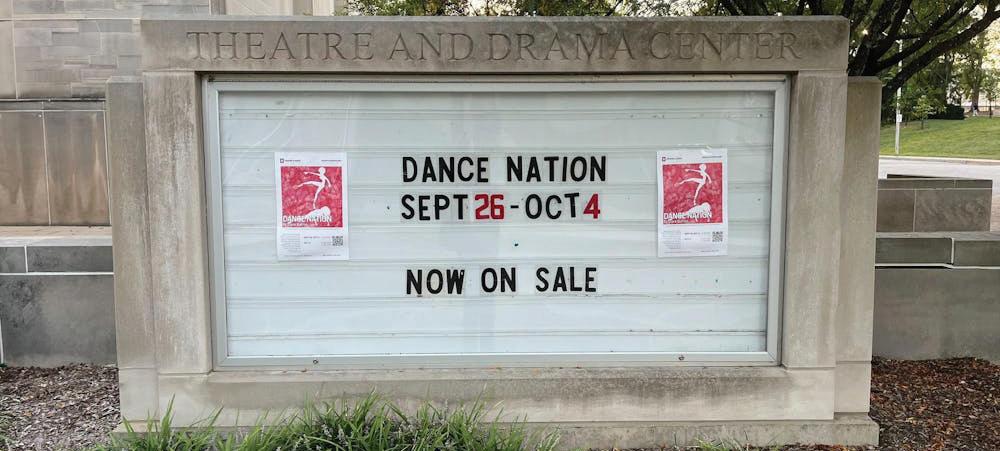
while listening to his mom. I loved that the tweens had their own moments to stand apart from the others and speak — to themselves, to the sky, to the audience. Some monologues were long, like Rong’s rant about beauty, the math section of the SAT and the fear of trying. Others were short, like Vaishu Majji’s quiet moment in which Connie reflects on mental health struggles and the human connection.
In the end, “Dance Nation” isn’t so much a coherent story as a slice-of-life piece that realistically portrays what it’s like to be 13, unsure of your place in the world yet desperate to find it.
The authenticity of feelings is the show’s greatest strength, but it’s not perfect. The derailing of the plot toward the end is frustrating.
In theory, “Dance Nation” follows the dancers from Liverpool, Ohio, as they seek national glory.
However, the dance company doesn’t make it to nationals. Not because they don’t qualify, but because the show ends after the first of three competitions that they need to win to get there. There’s so much left unresolved, both in terms of the overarching plot as well little vignettes that hint at things like sexual assault, body image issues and lost friendships.
I realize these hanging questions are yet another way in which the show reflects the real world — after
all, there are so many things in life that we just never get to know — but it did feel like there were too many loose ends left at the end of the play.
In fact, that was one of the most abrupt endings to a show I’ve ever seen. It was impactful, but it wasn’t a conclusion. It just stopped. As I was leaving, I overheard someone near me say, “I have never been more confused about a show in my entire life,” to which her companion responded helplessly, “I have to write an essay about that?” I don’t think it would be hard to write an essay about “Dance Nation”, since there are plenty of moments to analyze. The dance routine about Gandhi, for example, and the mention of his hunger strike subtly tie in with themes of disordered eating we often see in the dance world. The show never hits you over the head with that sort of allusion, which I appreciate.
It does hit you over the head, however, with coarse language and crassness. To some extent, that adds to the realism of the show — the characters are 13, after all — but I think the play went overboard. Much of the talk of genitals and sex felt gratuitous, especially in the last few scenes. In the end, there’s plenty to talk about after seeing “Dance Nation.” More importantly, there’s even more to feel while watching it.
By Will Tallackson wdtallac@iu.edu
Heidi Mariam Fitzgerald transformed her creativity and passion for fashion design into living art as the featured artist at this year’s Lotus World Music & Arts Festival.
Fitzgerald invited festivalgoers to roll up their sleeves for a hands-on experience in Indian woodblock printing and bandanas.
Outside the Monroe County Public Library on Kirkwood Avenue on Sept. 27, families and children lined up to press carved wooden blocks with vibrant ink on ornamented fabric. With Fitzgerald’s help, they created colorful mystic patterns and animal motifs onto their bandanas — a piece of the festival they could carry home.
“The possibilities of what it could become were very exciting,” Lotus attendee Michele O’Mara said. “I can’t wait to take this home as something I will remember about this day.”
For Fitzgerald, those ideas are closely tied to her belief that art should strike a balance between creativity and pragmatism.
“What I actually really like is this combination of art and craft, so that the art has a kind of framework, and it doesn’t, it’s creative, but it doesn’t go beyond a certain level where it loses its meaning,” Fitzgerald said.
“So, I like the combination of functionality and art, that
By Ursula Stickelmaier
ustickel@iu.edu | @urose_18

there’s beauty, but there’s also practicality.” Fitzgerald’s path to becoming the festival’s featured artist spans continents. She grew up in southern Germany, where art was appreciated on both sides of her family.
Her paternal grandmother painted fashion illustrations for books during World War II, and her maternal grandmother sewed clothing for her children. Fitzgerald followed in their footsteps with a love for both painting and making clothes, as well as many other types of art.
She first came to Bloomington as a teenager on a foreign exchange program. Later, she studied apparel merchandising and fashion design at Indiana University, even working at the IU opera costume shop.
Her education continued at Modefachschule Sigmaringen, a fashion school in southern Germany. She went on to work across German-speaking Europe before relocating to Paris, where she worked in costume shops and haute couture studios.
“It gave me a broadened
imagination of what is there, what is possible,” Fitzgerald said. “And the beauty of costume places in Paris is that they’re actually often quite old-fashioned.”
Fitzgerald returned to Bloomington in 2006 to raise a family. With two children and a desire to create a space that reflected the cultural diversity she experienced abroad, she opened the Lotus Studio of Perennial Arts & Crafts.
The studio doubles as both her design space and a teaching hub, offering workshops for families that have
ranged from sewing and fabric printing to Ukrainian Easter egg decorating and Native American bead looming.
“To be able to create a space where the younger children can come in and learn easily and be taught meaningful crafts fosters a sense of purpose,” Fitzgerald said.
That philosophy of hers carried into this year’s festival as Katarina Koch, the Lotus Education and Arts Foundation executive director, approached Fitzgerald at last year’s Bloomington
Handmade Market. Inspired by her business and work at her studio, Koch knew that her contribution to the Lotus Festival would make a great addition.
“She brings a piece of her own heritage to the festival, while allowing kids and adults to participate in artwork that fosters a sense of community,” Koch said. For Fitzgerald, this partnership felt like a natural extension of her mission to share cultural traditions through art.
“I was thrilled to collaborate with Lotus,” Fitzgerald said. “They focus on traditional music from around the world. I focus on traditional arts and crafts from around the world. It goes well together.”
Following the festival, Fitzgerald will turn her focus to expanding her fashion studio. She will host a twoday event from 3-6 p.m. Oct. 3 and 4 at the Lotus Studio of Perennial Arts & Crafts at 212 S. Rogers St. for visitors to try on clothes and place custom orders for her clothing. For now, Fitzgerald said she hopes her work will continue to inspire, one seam at a time.
“Life is a lot more enjoyable when you’re surrounded by beauty,” she said. “It’s nice to dress nicely, it’s nice to look at people who are well dressed, and it makes life much more pleasant. That’s something I think art and fashion can really give to a community.”
SPOILER ALERT: This column contains potential spoilers about “All of You.”
Love takes a tragic turn for the worst in Apple TV’s “All of You,” and that’s putting it lightly. After premiering at the Toronto International Film Festival on Sept. 7, 2024, the film is finally available to the general public just over a year later on Apple TV. But what’s described as a complicated love story between two lifelong friends actually paints a more sorrowful picture of romance than some might realize.
The movie is centered around best friends Laura (Imogen Poots) and Simon (Brett Goldstein), and follows their friendship through the years. Set in a fictional world where a company called Soul Connex has invented a test to determine who your soulmate is, the two friends must spend years trying to fight the undeniable fact that their bond is much more than platonic. When I read the synopsis on Apple TV, the film seemed both sad and a little dreamy. Described as two friends fighting the urge to risk everything and “explore a love
By Abby Whited abwhited@iu.edu
that has existed all along,” it felt like I was stepping into some epic, if not slightly tragic, friends-to-lovers romance. But while romance is a driving element throughout this movie, I think horror might be a more fitting genre. When it starts out, Laura and Simon are just friends — though it seems obvious to the viewer there’s something more between them. However, the two characters make no indication towards acknowledging it. Regardless of what they might feel, Laura is set to take the Soul Connex soulmate test which, as Simon puts it, will probably mean she’ll get too wrapped up to ever hang out with him again.
Simon, on the other hand, is adamantly against the test, an attitude that remains true through the entire movie. He’s adamant that true love is meant to be something you find on your own, not something that’s found for you. It’s hard to find just one word that fits how it feels to watch Simon throughout this movie. But I tried. The closest word I could come up with was pitiful. Now I know that sounds harsh, but more than anything else, Simon’s arc through the movie just
led me to feel more and more sorry for him. Laura takes the test and finds her soulmate, Lukas (Steven Cree). Laura gets married and has a kid. Simon, he’s just there. Like some static, unmoving thing that sits in the background of her life waiting for her to love him. And when the movie ends, leaving their futures open-ended as he heads to United States and they say goodbye for the last time, Simon is left without closure or a guaranteed future like Laura is. He’s just there, about to start a new chapter where he might finally feel free to be happy, but after witnessing the last hour and 40 minutes of the film, as a viewer it’s hard to believe he’ll even get that.
The film tries to depict poor timing as the antagonist in their story, but the real villain in this film is Laura. She cheats on her husband throughout the film, starting with an emotional affair with Simon that eventually turns into the real thing. She lies to her family and then paints herself a victim when things don’t go her way. It’s embarrassing for her and, as a viewer, it’s infuriating to watch.
Through every time skip

in the movie, it feels like Laura becomes more and more of a stranger to the girl she was at the beginning. She doesn’t want Simon to leave her, but she also won’t leave her husband. I get the aversion towards blowing up her life but at a certain point it was more frustrating than anything else that she refused to make a choice.
The romantic montages of them together are constantly undercut by the fact that you know there’s nothing sweet about what they’re doing. Their trips out of town and time spent in cozy cabins isn’t done because they want some dreamy couples’
vacation, it’s done because they have to. It’s done because clandestine meetings in places far from their friends and family are the only way their relationship works without them getting caught. No amount of whimsical instrumental music is going to change the fact that this isn’t romance, it’s just some sad nightmare that leaves you hurting for Laura’s husband and daughter.
It’s tragic, but it would be unfair for me to say this film was all bad. Every shot in this movie felt more as if I’m an outsider eavesdropping on someone else’s life. And because of that, every moment
— no matter how uncomfortable — felt more real. The chemistry between Goldstein and Poots was also very strong, which in turn makes both the highs and lows of their relationship that much more painful and realistic.
“All of You” is a hard watch, but it portrays the decades-old love between Simon and Laura in a real and honest light, even if that light may be a harsh one. It’s sad at times and might leave you feeling a bit emptier than you would think, but if you’re looking for a candid portrayal of loving the right person at the wrong time, this is the movie for you.
Autumn is my favorite time of year for fashion. Ideally, the weather is not too warm but not too cold, just comfortable; this allows for the perfect conditions to experiment with your outfits. It can seem intimidating to transition from summer to fall fashion, but by utilizing what you already have in your wardrobe, it is possible to adapt seamlessly into the season. Here are my essential tips for dressing your best this fall season.
Try out different textures
In the summertime, comfort is essential, so we tend to gravitate more towards light, breathable fabrics like linen. Autumn weather can give you new possibilities when it comes to your wardrobe. As the weather gets chillier, you’ll have more opportunities to try out different textures and heavier fabrics.
A comfortable wool sweater is an essential fall staple, but it isn’t the only kind of material that is well suited for when the temperature drops and the leaves change color. A leather or faux-leather jacket may be too heavy for the summer, but it is the perfect mate-
rial to take the autumn chill off your shoulders. Velvet is also a thicker fabric that not only provides warmth but adds a sense of playfulness and style to any ensemble. Finally, there’s flannel, which is perhaps the fabric most associated with the fall, but for good reason — it’s comfortable, light and easily layerable.
Experiment with layering
Although layering has its practical benefits — namely, keeping you warm when there is an autumn chill in the air — it is often what can take an outfit from basic to interesting. Layering your clothing allows you to mix colors, patterns and textures, giving your outfit more dimension and flair. When you think of layering, you might first think of jackets or cardigan-style sweaters over a simple camisole. While these are perfectly acceptable, getting more creative with your layering choices can truly elevate a fall ensemble. Think of a long-sleeved shirt or turtleneck with a vest over it, or a pair of patterned tights with a dress and jacket. These types of combinations can really exude elegance, making you appear more put together.
Accessorize more
Implementing accessories is the key to making any seasonal style change. Whether it’s through belts, jewelry or handbags, good accessories can truly elevate any fall ensemble.
Think of accessories as the finishing touch that can bring an outfit to life. A sim ple outfit can really benefit from a coordinating purse or belt as an extra pop of color. A variety of rings and bracelets can also help to complete your fall style endeavors. Belts are perhaps the most simple way to make your outfit look cohe sive and well-thought out, especially if you match them to the col or of your shoes. As you continue to experiment with your fall fashion, consider accessorizing as the final step to tying your look together.
Embrace an autumn color palette While it’s true that the right outfit can make any color work no matter the time of year, a simple way to embrace fall through your personal style is to implement the autumn color palette within your
outfits. Just as the leaves in fall change from green to orange, red and brown, your outfits can change colors with the fall season.
Don’t worry, dressing in autumn colors doesn’t have to mean sticking to neu
without simply dressing in brown or beige. Shades of maroon and burgundy often come back into the trend cycle each fall, and the colors can flatter a variety of skin tones. Summer may be over, but


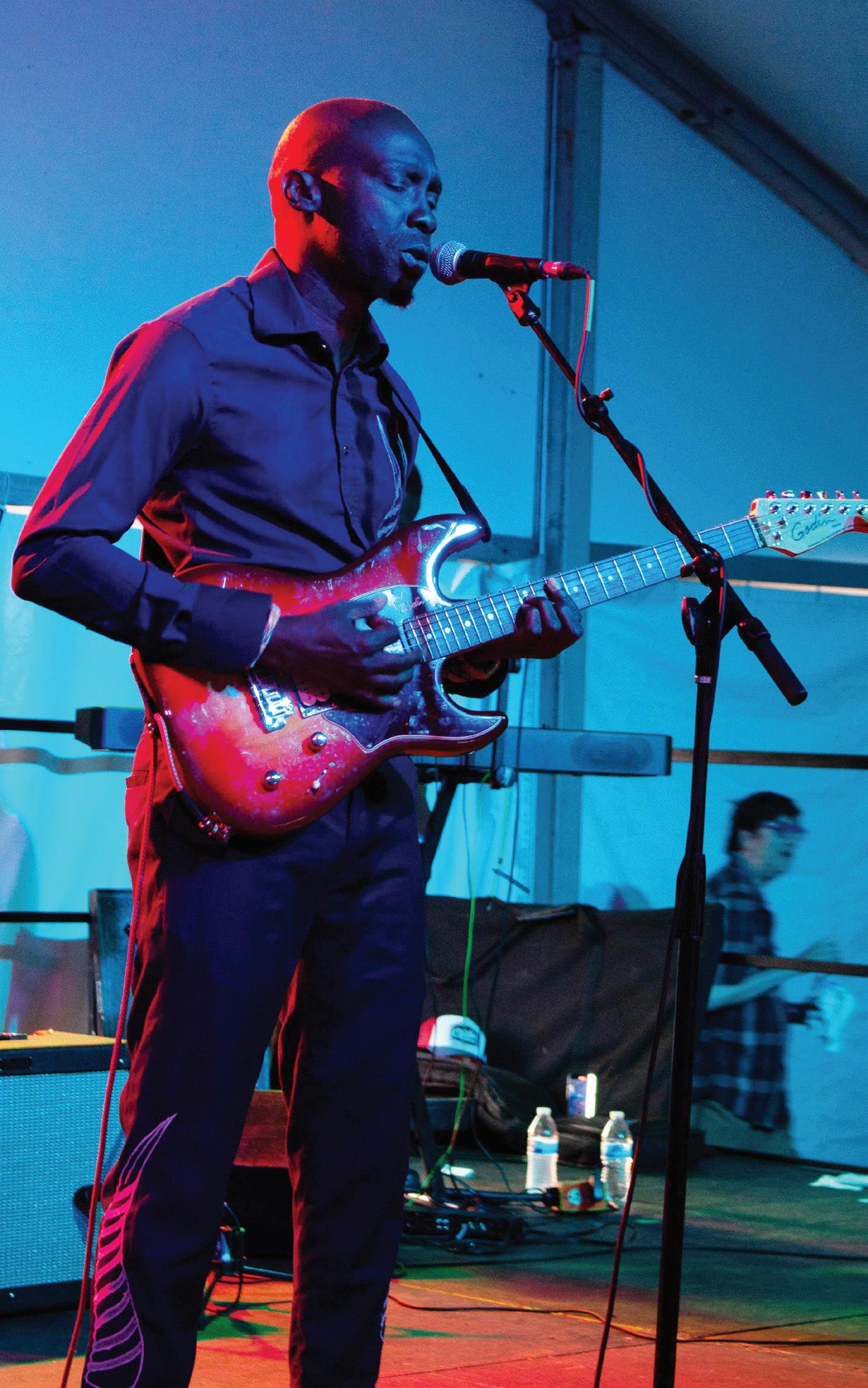





By Dalton James jamesdm@iu.edu | @daltonmjames
IOWA CITY, Iowa —
Then-No. 11 Indiana
football’s offense wasn’t looking itself.
After scoring a touchdown on its second play from scrimmage, the Hoosiers stumbled. Gone were the effortless throws. Gone were the easily broken tackles. Gone was the near perfect pass protection.
Still, Indiana stood a yard into plus territory, facing third and 10 tied at 13 against Iowa with under two minutes remaining. It was crunch time — an incompletion would’ve led to a punt while a conversion would’ve kept the drive alive.
Phil Parker dialed up Cover Zero blitzes for the duration of Indiana’s possession. The 14th-year Iowa defensive coordinator sent one more defender than Indiana could block. Parker’s unit had told the Hoosiers they weren’t going to successfully throw the ball against the look, Mendoza said.
Sarratt reminded Indiana’s receiving corps to be ready for Cover Zero throughout the game.
Teams “like to do that to us,” he said. Then, with 1:41 left in the final quarter, Indiana offensive coordinator Mike Shanahan reused an earlier unsuccessful play call — Sarratt didn’t break free on his slant that time.
Now, Sarratt saw the Hawkeyes’ safety moving toward the line of scrimmage to blitz Mendoza. The Stafford, Virginia, native said he knew he needed to speed up his route and flatten it off.
Mendoza — who threw his first interception of the season on the prior possession — caught the snap, stood in the pocket and made a perfect throw to Sarratt, the latter said.
On his sixth reception of the day, Sarratt broke an arm tackle and scored a 49-yard touchdown.
Sarratt was “hyped,” he said, and was ready to yell before he had even reached the end zone. Redshirt
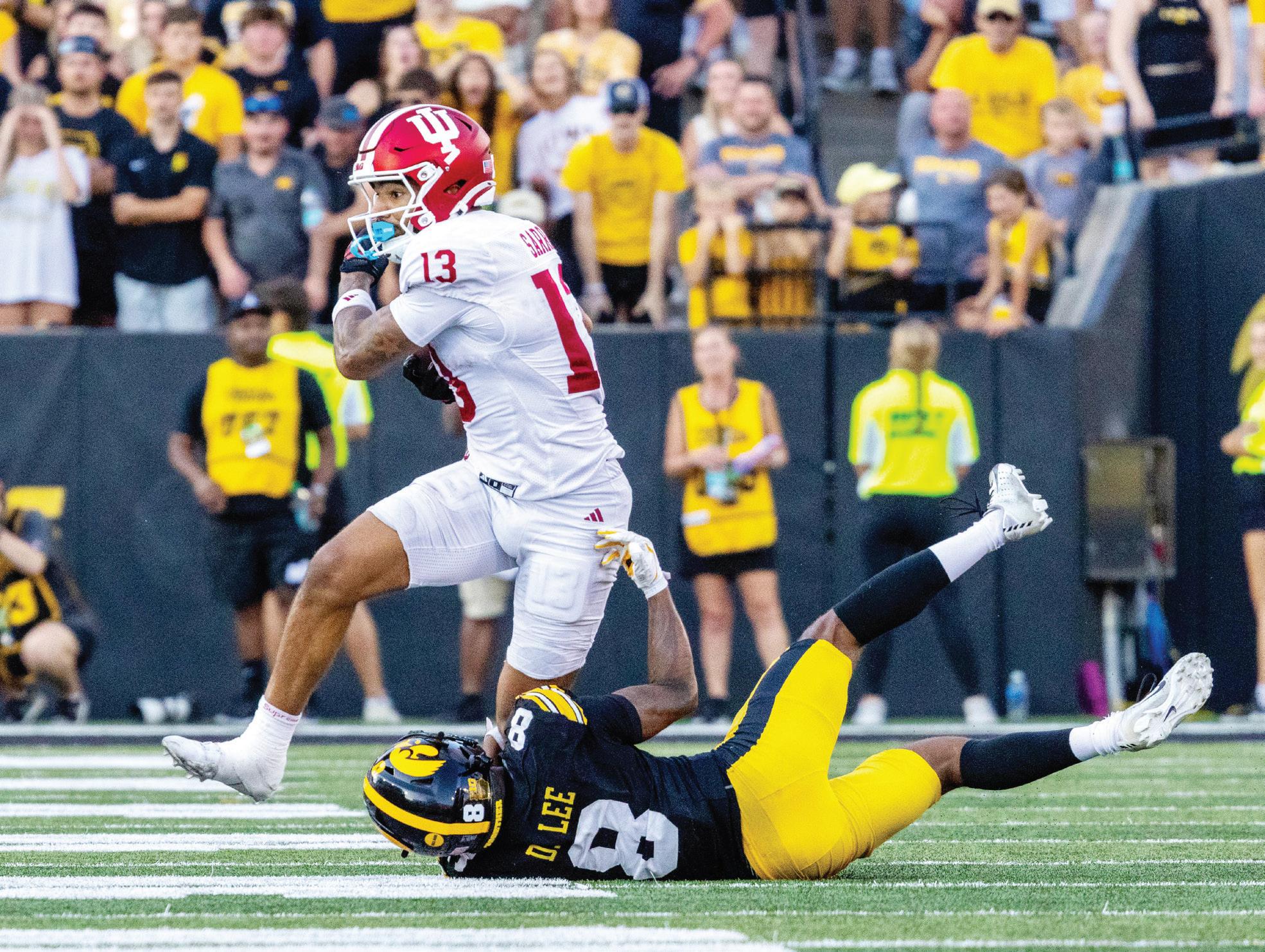
senior center Pat Coogan embraced Mendoza and thanked Jesus. It was the play Cignetti said he’ll remember from the Hoosiers’ first road game of the season.
But senior linebacker Aiden Fisher wasn’t surprised.
“Nothing shocked me about (the play),” Fisher said postgame. “When I saw the ball in his hands, I was like, ‘Yeah, that’s probably the game right there.’”
On a sunny, 85-degree day at a place in which top teams have “gone to die,” former Michigan head coach Jim Harbaugh said in 2016, Indiana escaped Kinnick Stadium with a 2015 win to improve to 5-0 for the second consecutive season.
This season, the Cream and Crimson had yet to make a fourth-quarter comeback before Sept. 27. They didn’t need to. After the Hoosiers’ 13-point win in the season opener, they had defeated their opponents by
47, 73 and 53 points. Sept. 27 was different. The offense wasn’t clicking on nearly all cylinders. Mendoza had more incompletions than touchdowns, which he hadn’t done since Sept. 6 against Kennesaw State University. The Hoosiers’ rushing attack gained a measly 14 yards (excluding Mendoza’s intentional safety) compared to the 308.8 they averaged over their first four games.
The Hawkeyes’ defense — which has been a highlight in 27th-year head coach Kirk Ferentz’s tenure — made life difficult for the second-ranked offense in the country.
Mendoza didn’t put together a near perfect performance, unlike against then-No. 9 Illinois on Sept. 20, when he nitpicked at his two incompletions. Instead, he described his showing as “subpar.”
“I need to get the receivers the ball more
accurately,” Mendoza said. “And I just got to be more accurate with the ball and make better decisions and on time. I kind of retracted to some old habits.” Cignetti noticed Mendoza lowered his eyes while he stood in the pocket a couple of times in the third quarter — Mendoza went just 2 for 5 for 8 yards passing in that period.
“I just got to be more accurate with the ball and make better decisions and on time.”
Fernando Mendoza, IU football Quarterback
On the final play of the third quarter, Indiana faced a third and 15. Mendoza evaded the rush and scrambled near the firstdown marker. However, Iowa senior defensive back Xavier Nwankpa drilled Mendoza as he was heading
out of bounds. The play, which was deemed a legal hit despite the Hoosiers’ pleas for a penalty, “really kind of pulled our guys together,” Cignetti said.
“I’m never going to slide,” Mendoza said. “I’m always going to take that shot. And it’s because of the guys, like Elijah next to me, that would never give up. And so that’s my way to show the team that, ‘Hey, I’m never going to give up.’”
Mendoza completed just five of his 10 passes for 132 yards passing in the fourth quarter. He threw the gamewinning touchdown and an interception that could’ve cost the Hoosiers. But Mendoza connected with Sarratt in the clutch. The latter finished the contest with six receptions for 132 yards and a score.
The game-winning connection was a “big sense of relief” for Mendoza, he said. After Sarratt crossed the goal line, Mendoza
clasped his palms together, pointed and looked toward the sky.
“I mean, it was kind of like thanking God, just cause I always, before the game, I ask Jesus and God to play through me,” Mendoza said. “And I think that was the moment that he came and basically helped me get back in the game, maintain good poise, to be able to deliver the ball to Elijah.” Mendoza finished the contest 13 for 23 for 233 yards and two touchdowns and an interception.
Coogan deemed Mendoza, who stood in the pocket and absorbed hit after hit, a “tough S.O.B.” after the game.
“He’s someone that, as an offensive lineman, you’re like, ‘That’s my guy,’ ‘cause he’ll just do whatever it takes to win,” Coogan said. “And so proud of him, and just the way he continues the battle.” Indiana now enters its first bye week of the season at 5-0. The Hoosiers have two weeks to prepare for a trip Oct. 11 to No. 2 Oregon, which defeated then-No. 2 Penn State on the road Sept. 27. Moving forward, Coogan said the Cream and Crimson’s offensive line must protect Mendoza at an increased level.
Mendoza entered Sept. 27 as the favorite to win the Heisman Trophy. After Sept. 27’s slate of games, he sits with the sixth-best odds at +1400, according to FanDuel Sportsbook. Still, Mendoza “passed the test because he made the key play,” Cignetti said, in his first road game as a Hoosier.
“The kid is uber talented, and we got to let him shine; that’s our job,” Coogan said. “But for him to just battle and show the balls that he’s got and the guts that he’s got, it’s huge for this football team, and it’s awesome.” The ever-clutch Sarratt said to play Mendoza’s position, “you got to be a dog.”
“And he’s an example of a quarterback,” Sarratt said. “And there’s no other quarterback I would want to be throwing me the ball.”
By Quinn Richards qmrichar@iu.edu | @quinn_richa
Richards’ Report Card: The Hoosiers’ offensive line earned their lowest grade yet
The other day I watched “Rocky IV.” If you haven’t seen it, then avert your eyes because I’m going to spoil the movie. It’s been 40 years — that’s on you.
In “Rocky IV,” the titular protagonist Rocky Balboa travels to the Soviet Union to face Ivan Drago in front of a hostile Russian crowd. Despite taking a substantial beating for the first 11 rounds, the American Balboa ultimately lands the knockout punch in the 12th and final round, sending Drago to the ground for good. That’s sort of how it felt watching Indiana football’s 20-15 win over Iowa on Sept. 27 at Kinnick Stadium. There weren’t any Soviets in attendance nor punches thrown, but the Hoosiers persevered through an ugly back-and-forth Big Ten road test to stay undefeated. Even though Balboa won, he certainly wasn’t perfect. The same can be said about Indiana in my Week 4 edition of Richards’ Report Card.
Quarterbacks
Grade: C-
Running Backs
Grade: C+
Explanation: It’s not entirely fair to pin Indiana’s underwhelming 104 total rushing yards on the running back room. After accumulating over 300 yards in each of their first four games, a mediocre day was always going to feel drastically worse. It also didn’t help that Mendoza’s clock-chewing safety lost 40 yards on the last play of the game. Even so, redshirt senior Roman Hemby’s 15 carries for 86 yards were overshadowed by redshirt senior Kaelon Black’s mediocre day. Black was stuffed on fourth-and-1 on two different occasions, highlighting a harsh truth — running backs are only as good as their offensive line.
Receivers Grade: B+
Explanation: Mendoza only completed 13 passes, but Indiana’s wide receivers made the most out of them.
Five of the 13 completions gained 20 or more yards. Sarratt led the way with six catches for 132 yards — most of which came in the second half. The most impressive statistic in my opinion was the Hoosiers’ 133 yards after catch. Sarratt and redshirt junior Omar Cooper Jr. dazzled in the open field and turned good gains into great ones.
Sarratt’s aforementioned touchdown was a prime
Explanation: Redshirt junior quarterback Fernando Mendoza’s first interception of the year couldn’t come at a worse time. The turnover set up Iowa in field goal range with less than three minutes remaining in a tie game. It looked like Mendoza had put the final nail in Indiana’s coffin. Instead, one possession later, the Hoosiers’ signal caller delivered under duress, yielding a game-winning 49-yard touchdown pass to senior wide receiver Elijah Sarratt. Yes, Mendoza came through, but he undoubtedly played his worst game since arriving in Bloomington this offseason. The Hawkeyes’ blitz-heavy defensive scheme made him uncomfortable and showed noticeable flaws in the Heisman contender’s game.
example, as he broke a diving tackle attempt on his game-deciding dash to the end zone.
Offensive Line
Grade: D+
Explanation: For the first time this season, Indiana’s offensive trenches receive a poor grade. Mendoza was only sacked twice, but the Hoosiers gave up a seasonhigh six tackles for loss, two of which were on key fourth downs. The right side of Indiana’s offensive line — redshirt junior guard Bray Lynch and redshirt sixth-year senior tackle Kahlil Benson — routinely struggled to block their assignments.
Defensive Line
Grade: B
Explanation: Indiana’s defensive line had a hard time putting pressure on Iowa’s graduate quarterback Mark Gronowski. Granted, Gronowski’s running ability allowed him to evade potential danger on multiple occasions. Still, the Hoosiers’ defensive line limited the Hawkeyes’ run game, holding them to just three yards per carry. The Cream and Crimson defensive front was the first unit to hold Iowa to under 100 rushing yards this season.
Linebackers
Grade: C+
Explanation: I’m going to sound like a broken record because the linebackers showed similarities to the defensive line. Although redshirt junior Isaiah Jones and senior Kellan Wyatt combined for the team’s only sack, the unit struggled to cover routes across the middle of the field. Gronowski threw to
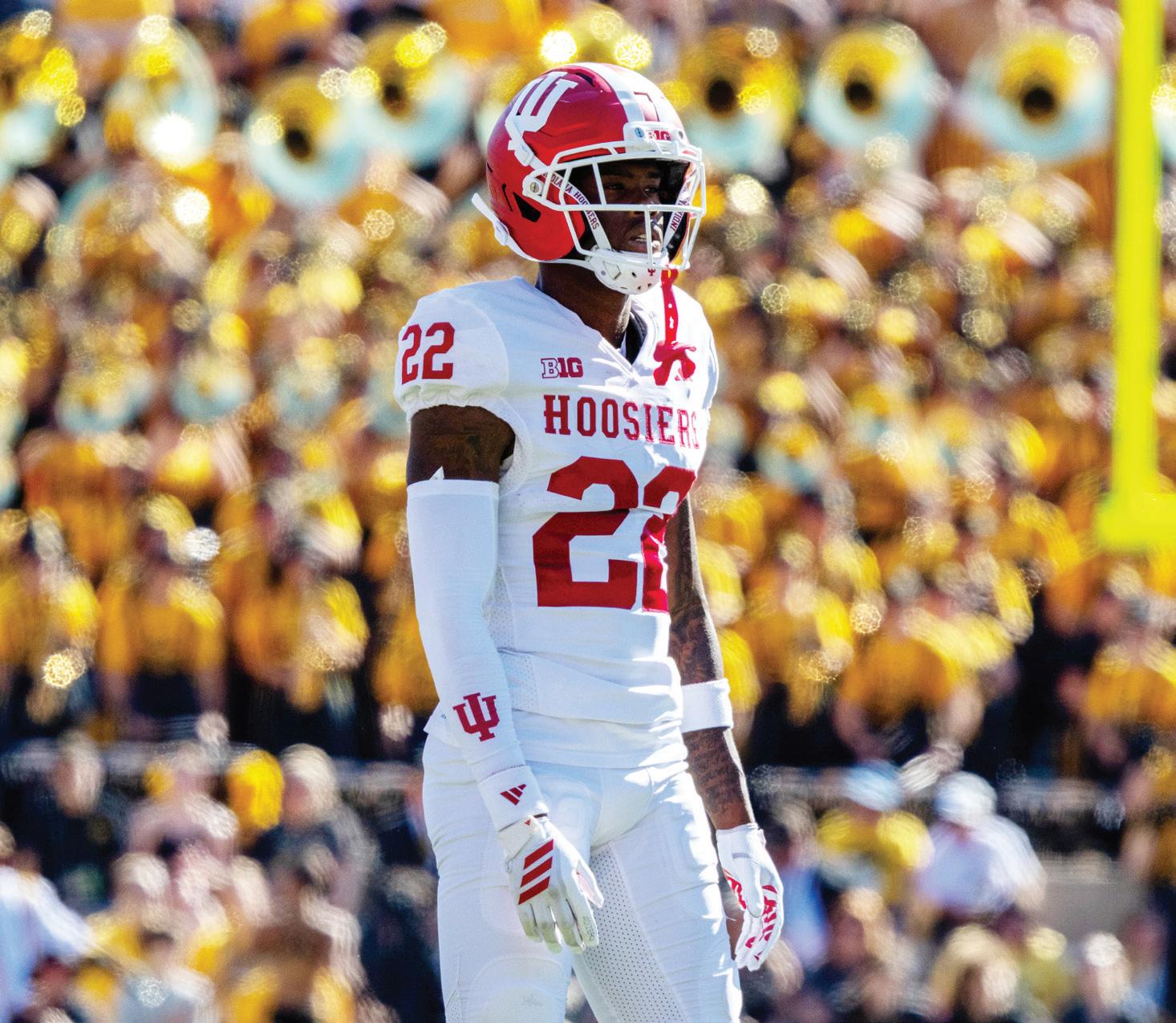
redshirt freshman tight end DJ Vonnahme there three times in the first quarter alone — twice resulting in third down conversions. Still, the linebackers worked well with the defensive line in front of them to blanket Iowa’s rushing attack. Jones, Wyatt and sophomore Rolijah Hardy all tallied tackles for loss.
Secondary Grade: C-
Explanation: Both junior safety Amare Ferrell and redshirt sixth-year senior Louis Moore recorded interceptions, which kept the grade from being terrible. Redshirt junior cornerback Jamari Sharpe’s inability to play man-coverage kept this grade from being good.
Iowa routinely looked his way, finding redshirt senior wide receiver Sam Phillips five times for 64 yards. As a whole, the Hoosiers’ secondary gave far too much cushion in man assignments and were undisciplined in zone coverages. It’s important to note that AllAmerican junior cornerback D’Angelo Ponds didn’t play against the Hawkeyes for an undisclosed reason. His absence was noticeable.
Special Teams Grade: A-
Explanation: The gameplan was simple — don’t let graduate returner Kaden Wetjen touch the football. Aside from the Hoosiers’ first punt of the game, that strategy was
followed to a tee. Senior punter Mitch McCarthy — who returned from a three-game injury-induced absence — averaged just 38.8 yards per punt, but that was a better alternative than giving the speedy Wetjen a chance at an explosive play. Aside from the punt game, Jones partially blocked a punt and redshirt sophomore kicker Nico Radicic drilled both of his field goal attempts from over 40 yards out. The only mistake the Hoosiers’ special teams made was senior punt returner Jonathan Brady’s fair catch on their own 3-yard line. Overall, special teams coordinator Grant Cain’s unit produced yet another great performance.
By Will Kwiatkowski wdkwiatk@iu.edu | @wwiatkowski_15
For the first time this season in conference action, Indiana scored in the first half — a breakthrough moment that set the tone for a fiery performance.
The Hoosiers came out with renewed energy, pressing Oregon’s defense early and often. A fresh front line brought hunger and intensity, and in the 37th minute, sophomore midfielder Maggie Ledwith opened the scoring off a well-placed assist from senior midfielder Natasha Kim.
“We had a different front line bringing us some energy today,” senior midfielder Olivia Rush said postgame. “Fresh legs into the lineup did a great job. Put a lot of pressure early on, brought a lot of energy.”
But the second half was a roller coaster.
Oregon came out with a new shape and immediately found success. In the 55th minute, Oregon junior forward Lauren Kenny scored the equalizer after a video assistant referee review confirmed her shot had crossed the line.
Indiana head coach Josh Rife acknowledged the tactical shift.
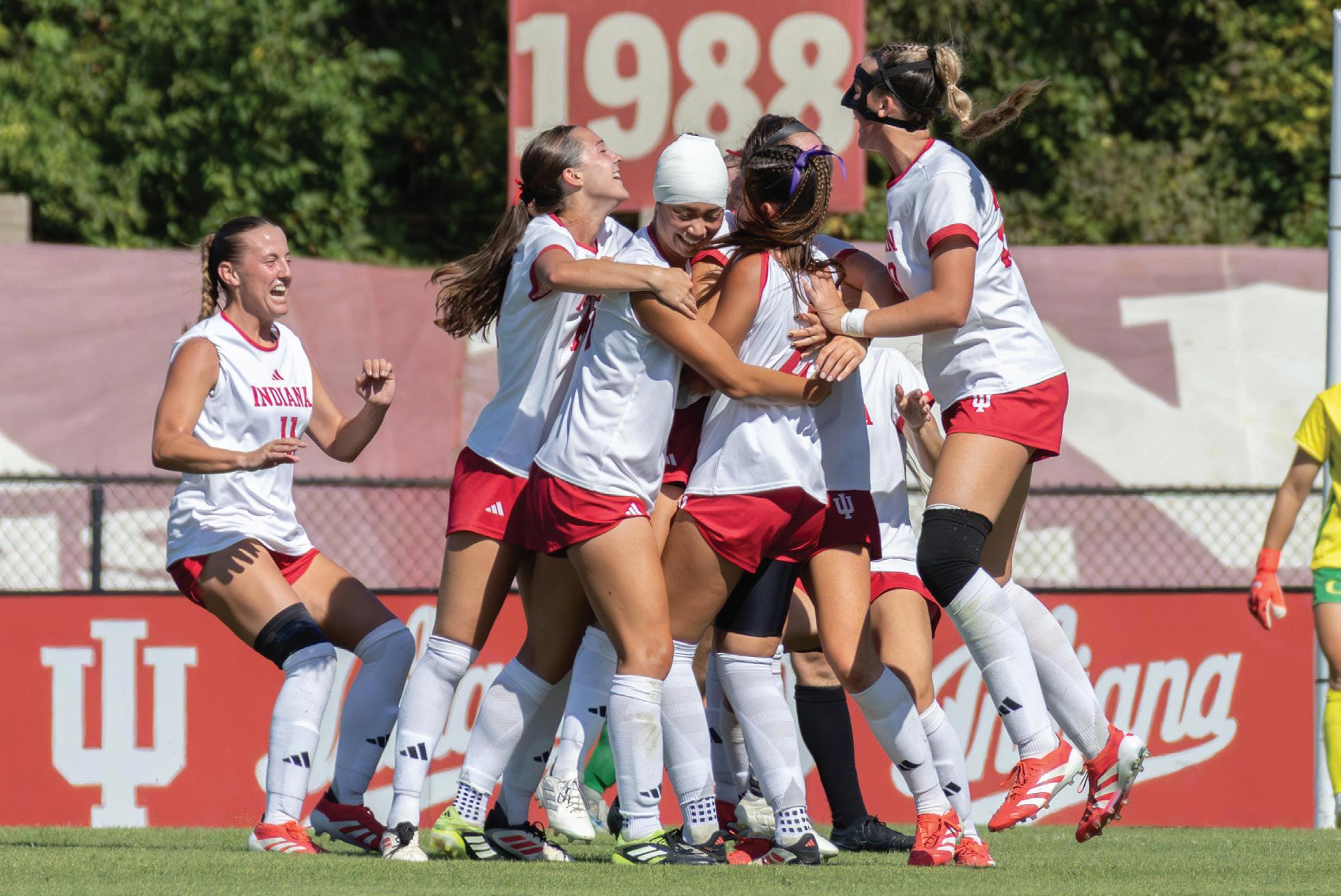
“They changed their shape coming out in the second half, and I think we were a little slow maybe as a staff to make those adjustments,” Rife said. Just five minutes later, Oregon struck again. Redshirt senior defender Jayde Holley finished off a well-worked play in the 60th minute, assisted by sixthyear forward Taylor Bryan and Kenny, to give the Ducks a 2–1 lead. Indiana’s defense looked rattled, and Oregon capitalized on the momentum.
In the 63rd minute, Oregon extended its lead to 3–1 when redshirt senior defender Cailin Bloom found the bottom right corner with a composed finish. The Hoosiers were suddenly staring down a two-goal deficit and a potential first home loss of the season.
But Indiana didn’t fold. Rife used the stoppages and
substitutions to rally his team.
“There’s a moment where I think we hung our heads,” he said. “But we had to push back and stay engaged. There was still a lot of game left to play.”
The comeback began in the 68th minute when graduate student midfielder Jenna Chatterton, fresh off the bench, scored with her
first touch. Her shot soared into the top left corner, assisted by junior midfielder Kennedy Neighbors, cutting the deficit to 3–2 and reigniting the crowd at Bill Armstrong Stadium. Then, in the 84th minute, Rush delivered the equalizer. After doing the dirty work defensively all game, Rush found space and buried a shot from outside
the Ducks’ box, leveling the score at 3–3.
“There’s a pressure and responsibility that comes with (being undefeated at home), but I have so much belief in this group,” Rush said. “We were hungry to get in front of goal, get rebounds, get crosses in. It was much better today than it has been.”
Indiana’s offense, which had struggled to find rhythm in previous matches, came alive with three different goal scorers. Rife praised the team’s depth and effort.
“Three different goal scorers today — that’s always a good thing for us,” Rife said. “There’s strength in numbers.” Looking ahead, Indiana shifts focus to a rivalry matchup against Purdue on Oct. 3.
After a wild 3–3 draw against Oregon, Indiana women’s soccer remains undefeated at Bill Armstrong Stadium, but the game served as more than just a point in Big Ten play — it was a test of composure, resilience and leadership.
“We can have emotion, but we can’t become emotional,” Rush said. “That’s going to be key Friday night.” Rife’s words weren’t just about the upcoming rivalry match against Purdue — they reflected the emotional roller coaster Indiana endured on the pitch Sept. 28.
By Kasey Watkins kaslwatk@iu.edu
Indiana volleyball opened home conference play Sept. 27 against Washington inside an energized Wilkinson Hall. Just minutes before the start of the match, Indiana football defeated Iowa to continue its perfect record, intensifying the energy and joy of the fans waiting for the start of the volleyball game.
This electric energy carried throughout the night and could be seen both through the fans and the action on the court. The game remained tight, with a difference of just 7 points across three sets combined.
While the Hoosiers were able to come out on top in each set to earn a sweep victory, their performance was not up to par with the standards eight-year head coach Steve Aird and the team set for themselves.
“I didn’t think we played very well,” Aird said postgame. “Our offensive numbers weren’t good, and I didn’t think ‘T’ [Teodora Kričković] was great.”

The Hoosiers were held to an overall average hitting percentage of just .196 on the night. Senior pin hitters Avry Tatum and Candela AlonsoCorcelles finished the night with uncharacteristic hitting averages of .000 and .129, respectively.
Alonso-Corcelles. Jager finished the night leading in total number of kills with 12 and an overall hitting percentage of .226. Boersema finished with nine kills and three blocks, and she led all Hoosiers with a .444 hitting percentage.
While the product on the court was not ideal for Aird, the Hoosiers rallied together to beat a talented conference opponent.
While Aird wasn’t pleased with the freshman’s performance in the match, he explained his high standards and tough love.
“She still may be one of
Freshman setter Teodora Kričković ranks sixth nationally and first among freshmen in assists per set with an average of 11.11. Despite critiques from her head coach, Kričković finished the night with 31 total assists. However, the lack of hitting efficiency falls on both the setter and the hitters.
the best freshman setters in the conference and one of the best freshmen in the country, but she wants to play in the Olympics, she wants to be a pro,” Aird said.
“She doesn’t want me to tell her she’s the prettiest girl in the room,” Aird continued. “I’m going to tell her the truth and coach her hard.”
Despite the offensive efficiency struggles on the night, the Hoosiers were resilient and found a way to win.
Freshman outside hitter Jaidyn Jager and sophomore middle blocker Ella Boersema stepped up big for the Hoosiers amid the struggles of upperclassmen key players in Tatum and
“Winning in the Big Ten is really hard and every team is good, and to start the year 2-0 in the Big Ten is good, and we’ll take it and get a little bit of rest tomorrow before we head up to the West Coast,” Aird said. The Hoosiers will next face off against USC on Oct. 3 at the Galen Center in Los Angeles. Indiana will need to clean up its play and make necessary changes as they continue into a tough conference schedule. While winning is good and important, this Indiana squad has their eyes on something bigger. “I just think we’re in the midst of a pretty special season, and I think we have the chance to really do some awesome stuff,” Aird said.
By Mateo Fuentes-Rohwer
matfuent@iu.edu | @mateo_frohwer
Clay Murador sits just outside the 18-yard box, lurking, watching, ready for a loose ball. The corner whips in, and the defensive clearance conveniently falls right to the junior forward.
He takes one shuffle, sets his feet and rifles the shot over the bar.
Murador spins his heels and looks up to the sky, unable to watch his strike soar over the trees behind the goal at DeMartin Stadium in East Lansing, Michigan.
Then-No. 3 Indiana men’s soccer would end up losing 1-0 to Michigan State on Sept. 23. His first collegiate goal eluded Murador through 34 appearances over three college seasons. He joked with his teammates every day that “today’s the day” he’d reach that milestone. Sept. 26 was that day.
Murador noted the situation was nearly similar, albeit a cross rather than a corner, to his attempt in East Lansing. Junior defender Alex Barger’s delivery was
Murador contributed a goal and two assists against UCLA
cleared out by a UCLA header, but the ball didn’t make it past Murador at the top of the box. His control with his chest took the ball away from goal but onto his trusty left foot. Then, with the confidence of a player with 20 goals in his career, Murador launched a rocket that sailed into the net.
Barger and sophomore forward Easton Bogard held their hands on their heads in shock and amazement. Murador ran to the corner flag, flanked by redshirt junior defender Breckin Minzey.
A jump, a punch of the air and a slap of the corner flag was Murador’s chosen celebration, accompanied by a smile stretching across his face. It was the second of four goals for Indiana men’s soccer in its 4-2 win over UCLA at Bill Armstrong Stadium.
But for Murador, it was more than just a tally in a game — it was a career moment.
Murador failed to register a single contribution through 30 appearances in his first two seasons with the
Hoosiers, but not for a lack of trying. His efforts on goal ended with shots off the posts, crossbars or saves by the keeper. Against Penn State last season, Murador finished off one of these chances, but the assistant referee waved it off for an offside. Head coach Todd Yeagley labeled it Murador’s “unofficial first goal” after the game against the Nittany Lions, and his stance on the matter hasn’t changed almost a year later.
“That was not offside,” Yeagley said postgame.
“That was like three yards onside last year. It was such a frustrating moment.”
Murador’s strong preseason gave even more reason for excitement. Yeagley frequently touted his winger as one of his best attackers based on the two exhibition matches, and his teammates felt the same.
“We knew what he had to offer in preseason,” senior forward Palmer Ault said. “He was absolutely flying.”
But an injury forced Murador out, leaving him on the bench for the first five matches of the season.
Indiana’s 1-0 win over the University of Notre Dame on Sept. 7 featured his first action of the year, and the progression to his top form has been slow but steady.
The outburst finally came against the Bruins.
“We knew it wasn’t going to take long once he got back in the lineup that he was going to get his first one,” Ault said. “So, you know, he was player of the match tonight, no doubt.”
Murador kicked off the party with Indiana’s first goal, providing a delicate pass to Barger on the overlapping run. The Hoosier left back then found Ault in the box for the first goal of the game only five minutes and 16 seconds into the match.
Next came Murador’s finish, only 10 minutes and 20 seconds after the first goal. The Aledo, Texas, native never has trouble striking the ball with power, as he was a kicker on his high school football team, but Yeagley analogized his scoring issues with golf.
“He’s picked and chose the wrong times in the past to hit the heavy club, the driver,”
Yeagley said. “So, he chose the right club and got all of it. When it leaves your foot, you know it. I’m sure he was like, ‘Oh boy, that felt good.’” The festivities continued as graduate student Ben Do’s cross found Murador in the box, and his header reached UCLA freshman goalkeeper Ryan Tiltack in net. Unlike most of his 10 saves in the match, Tiltack left the ball in front of him.
Bogard pounced on it for Indiana’s third goal in under 20 minutes and Murador’s second assist.
Halftime marked the end to Murador’s night, finishing with four shots, three on net, a goal and two assists. It was the standout performance in the front line, although Ault tacked on another goal to his Big Ten-leading tally. But Murador’s arrival to the squad and the scoresheet reflected a new attacking piece of Indiana’s puzzle, one Yeagley hopes to figure out and stabilize as the end of the season nears.

“He’s another gamechanging player for us,” Yeagley said. “I think him finding that tonight will only give us another weapon as we look to put out the group that we think can help us win matches.”
Once the dust settled, Indiana secured the three points and the Hoosier faithful left Bill Armstrong Stadium happy, Murador could finally declare one thing truthfully. Sept. 26, 2025, was the day.


